Development Of Dengue Virus Vaccine Components
Whitehead; Stephen S. ; et al.
U.S. patent application number 16/912359 was filed with the patent office on 2020-10-08 for development of dengue virus vaccine components. This patent application is currently assigned to The Government of the USA as represented by the Secretary, Dept. of Health and Human Services. The applicant listed for this patent is The Government of the USA as represented by the Secretary, Dept. of Health and Human Services, The Government of the USA as represented by the Secretary, Dept. of Health and Human Services. Invention is credited to Joseph E. Blaney, Ching-Juh Lai, Brian R. Murphy, Stephen S. Whitehead.
| Application Number | 20200318083 16/912359 |
| Document ID | / |
| Family ID | 1000004915705 |
| Filed Date | 2020-10-08 |
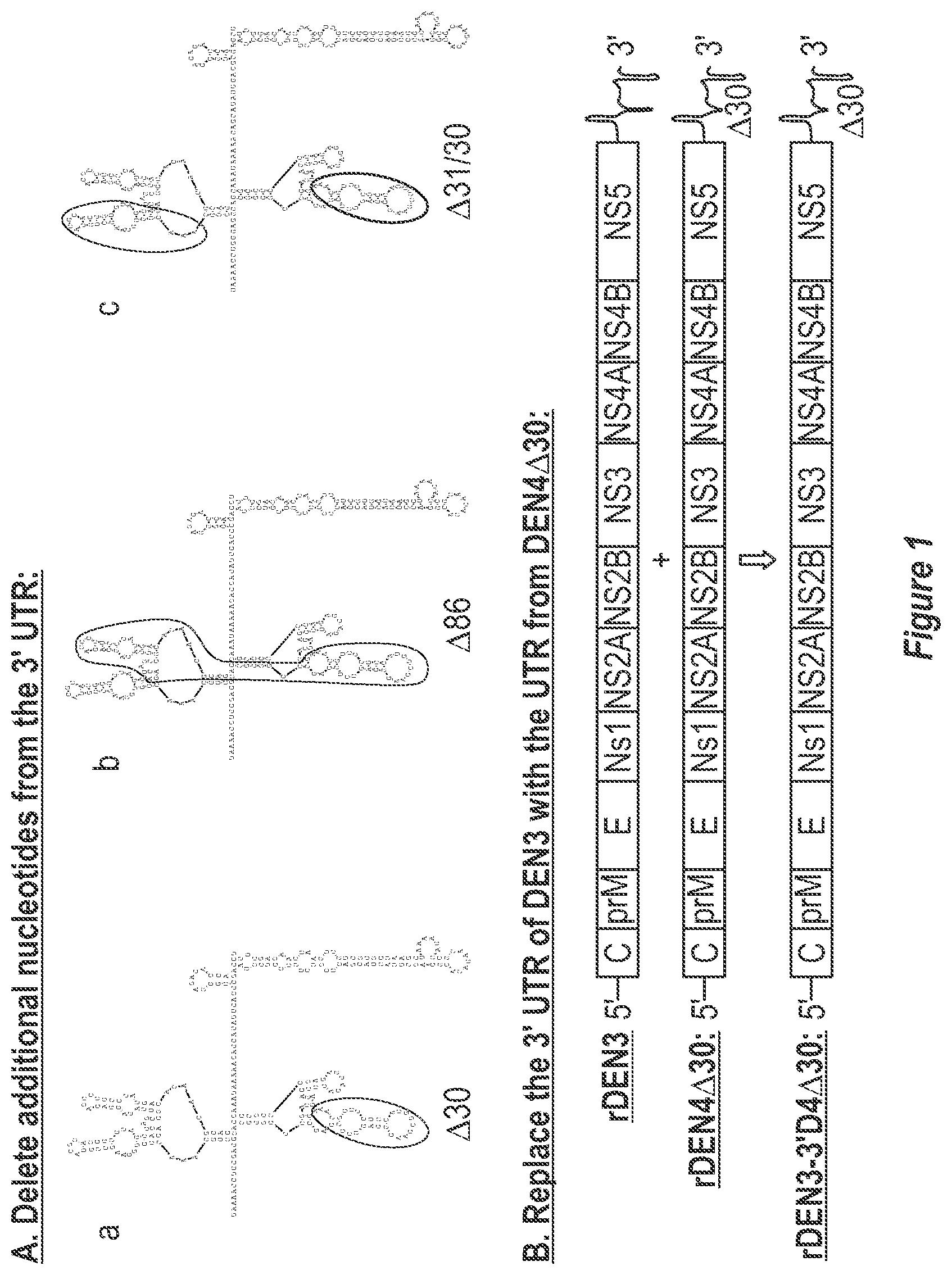
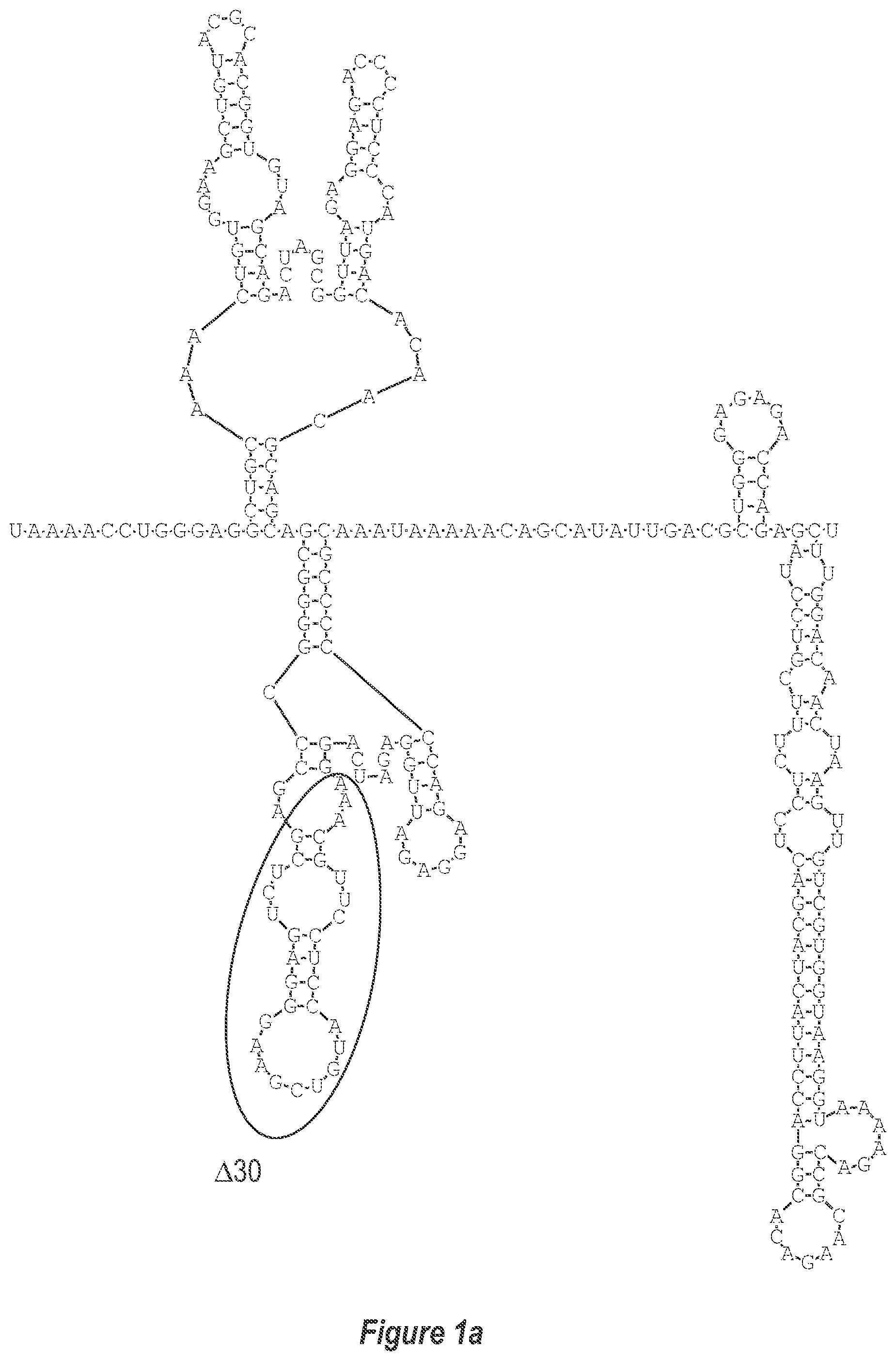
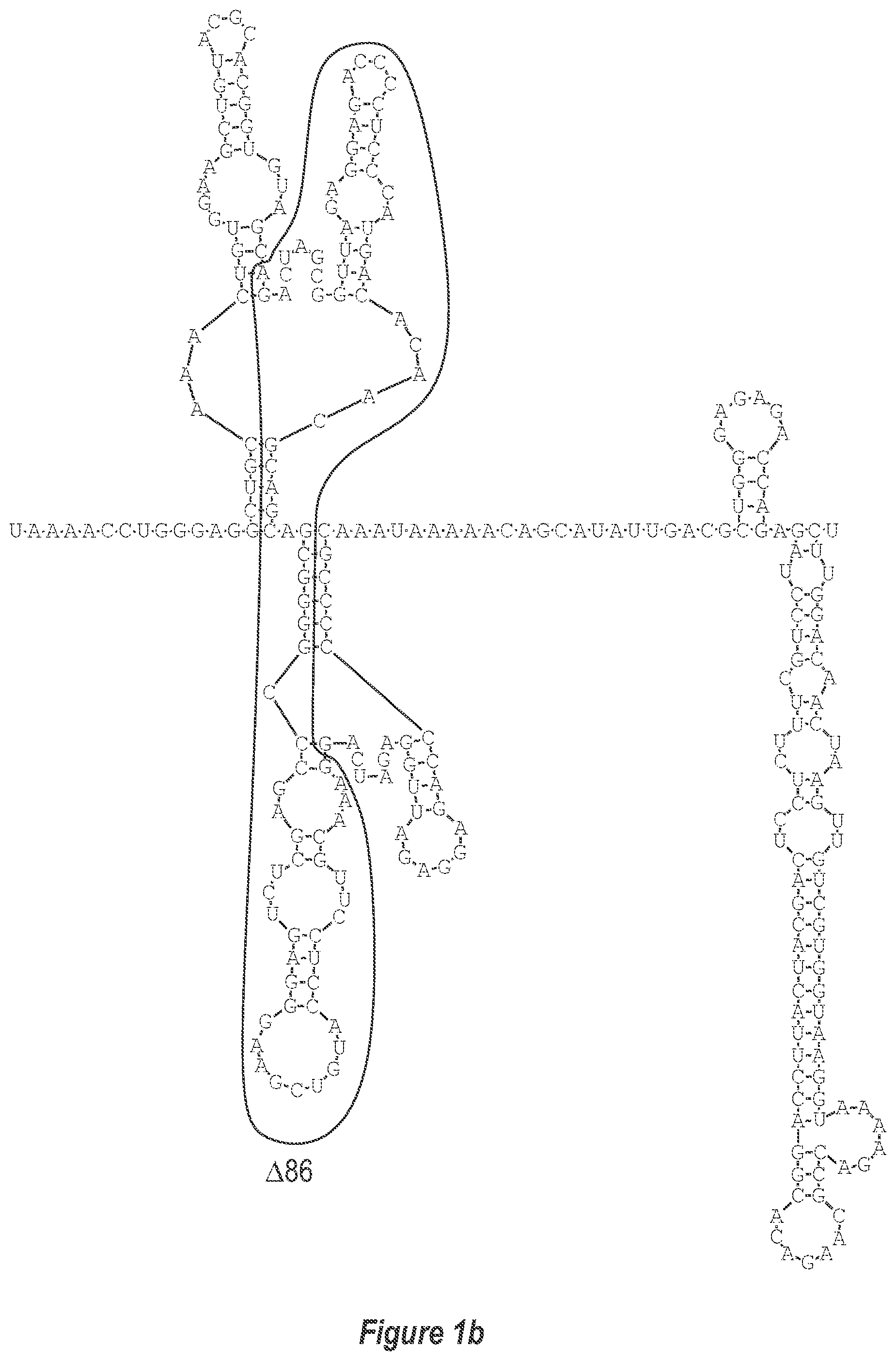
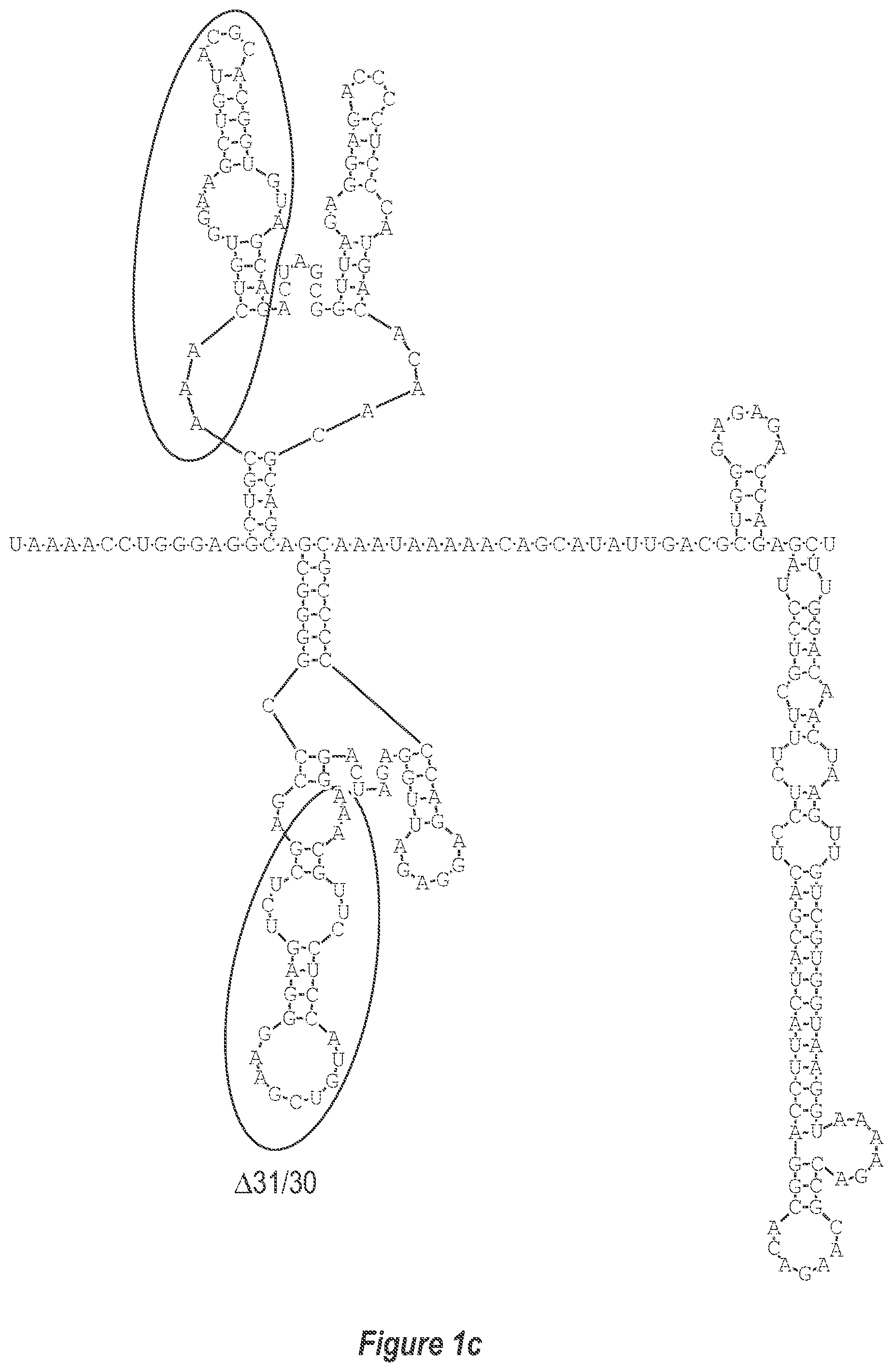
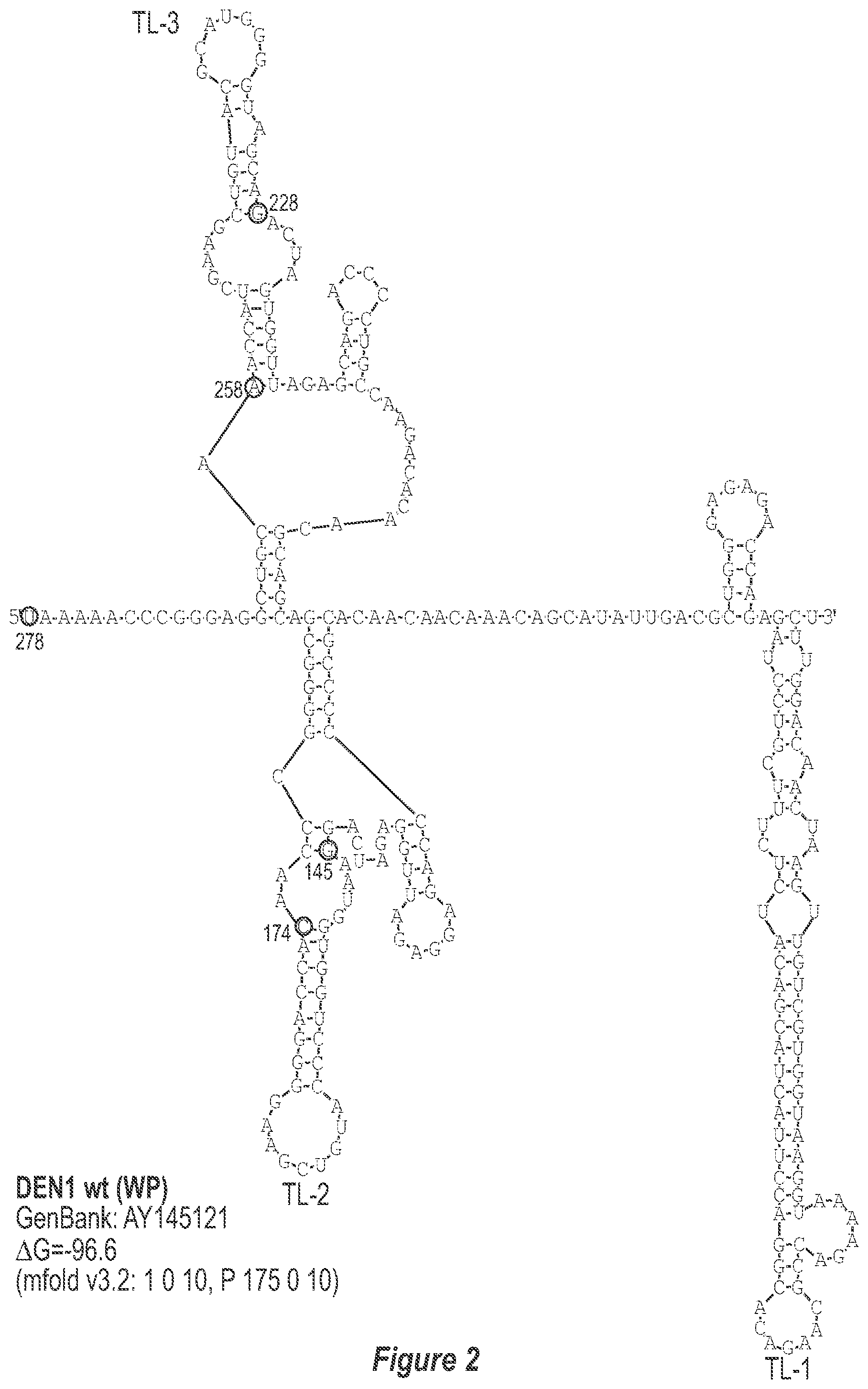
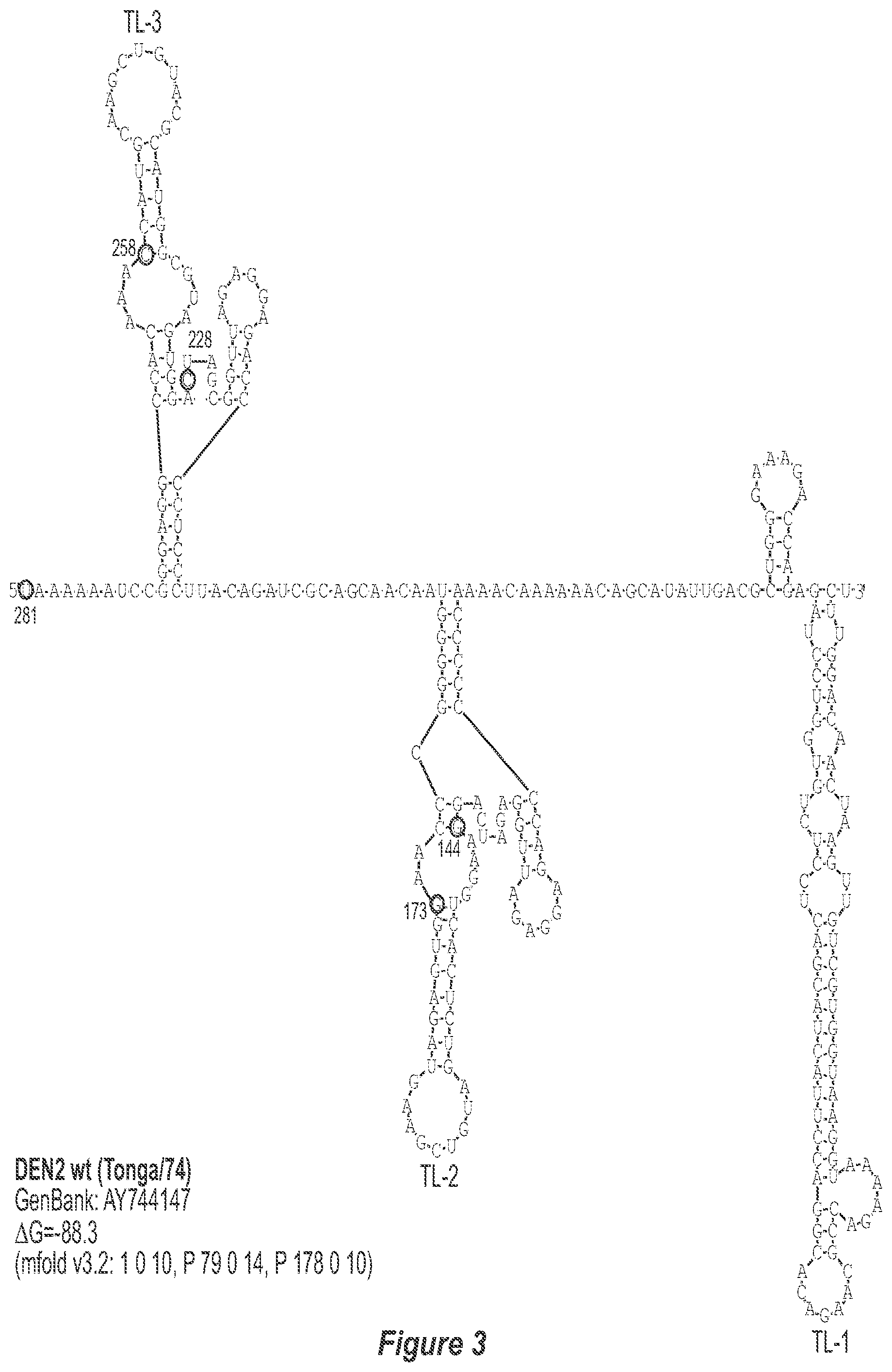
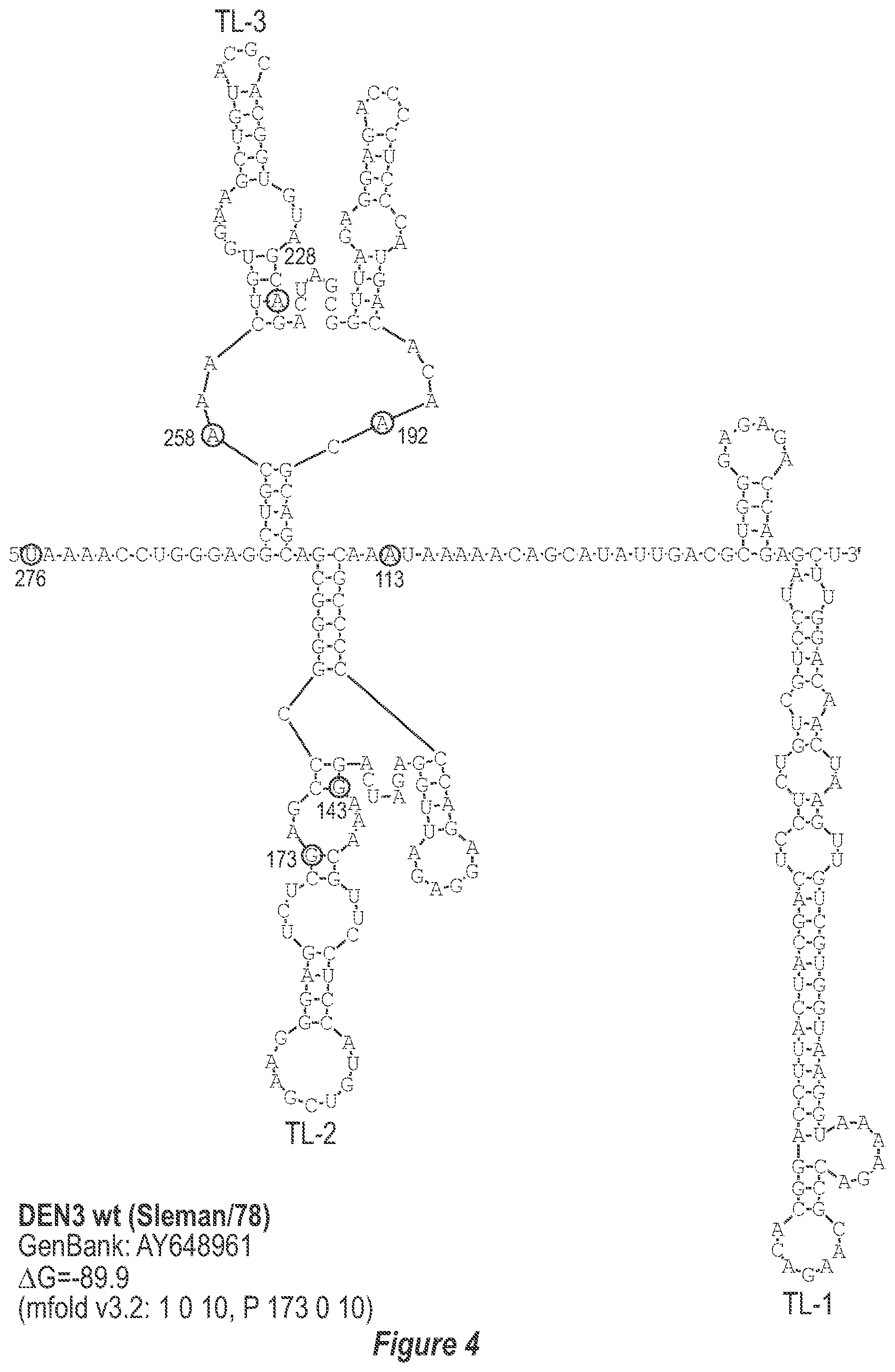
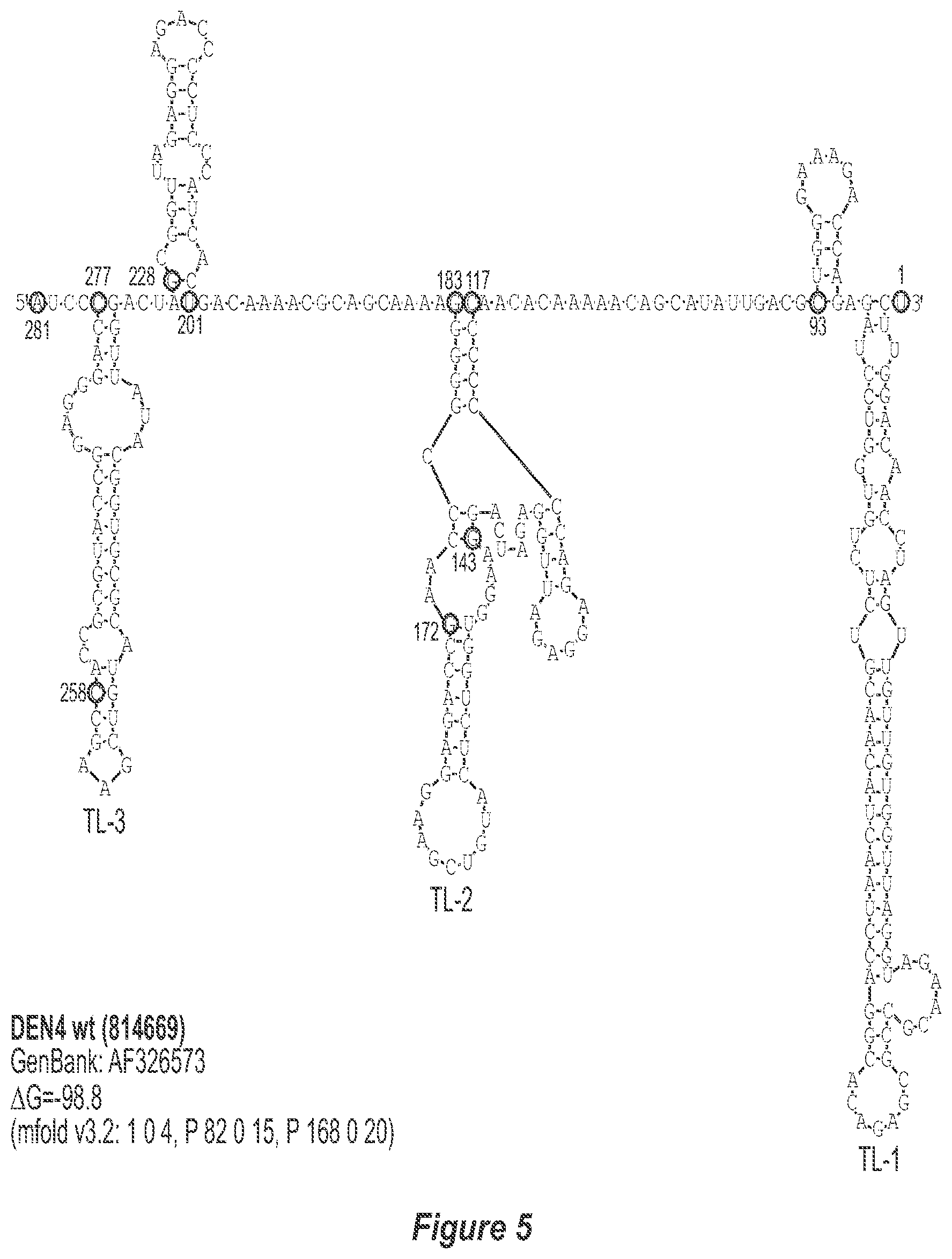
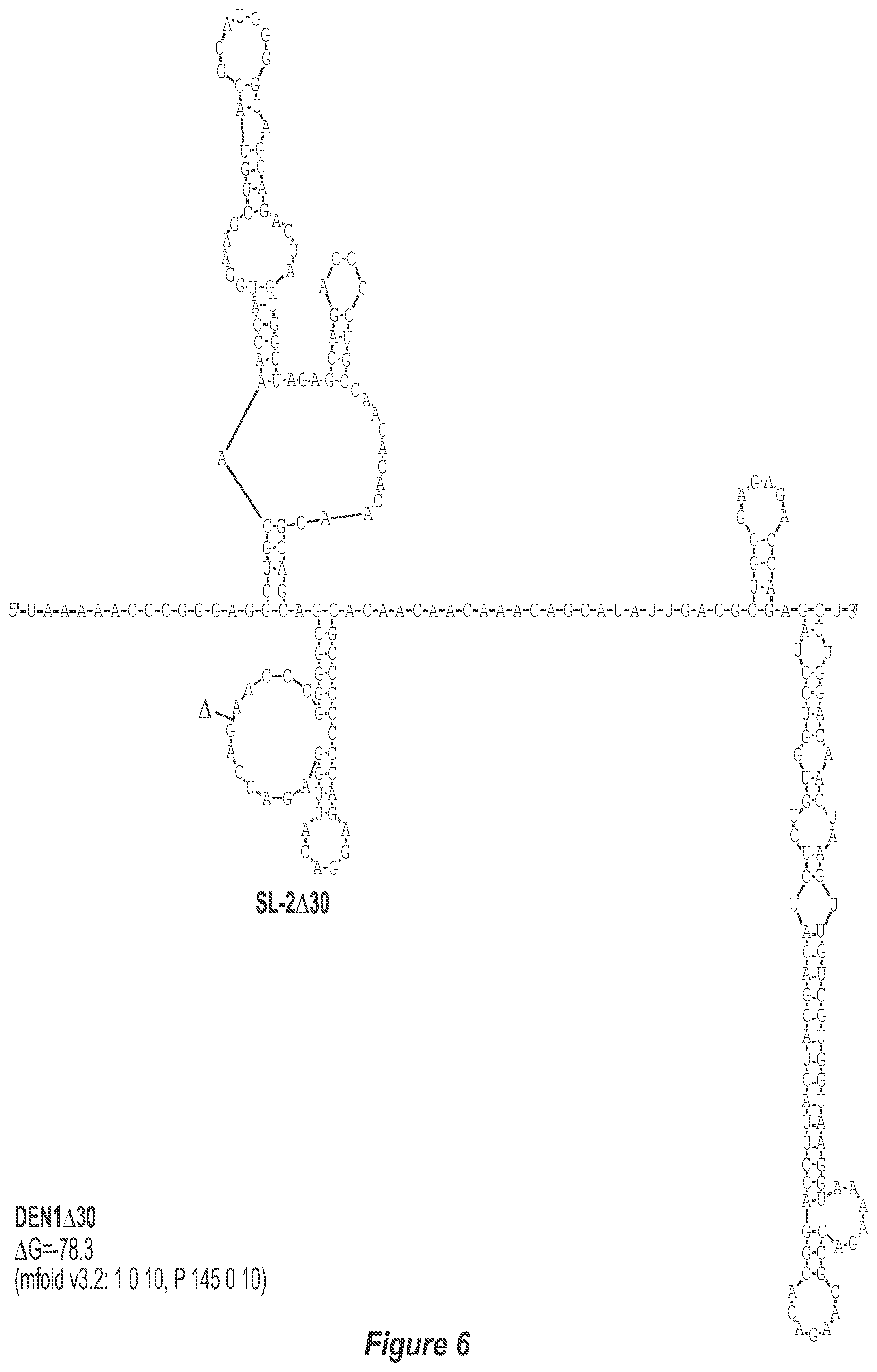
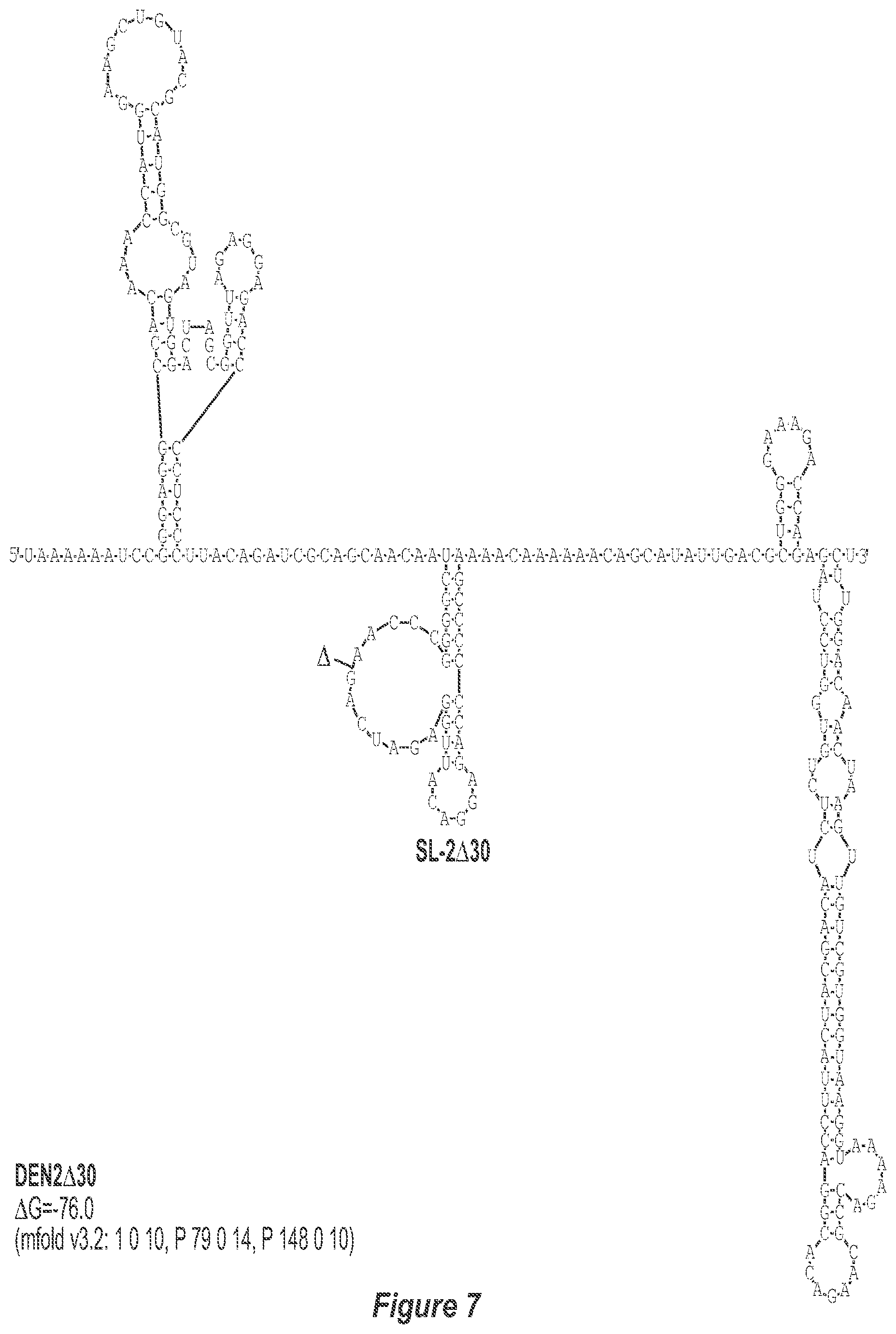
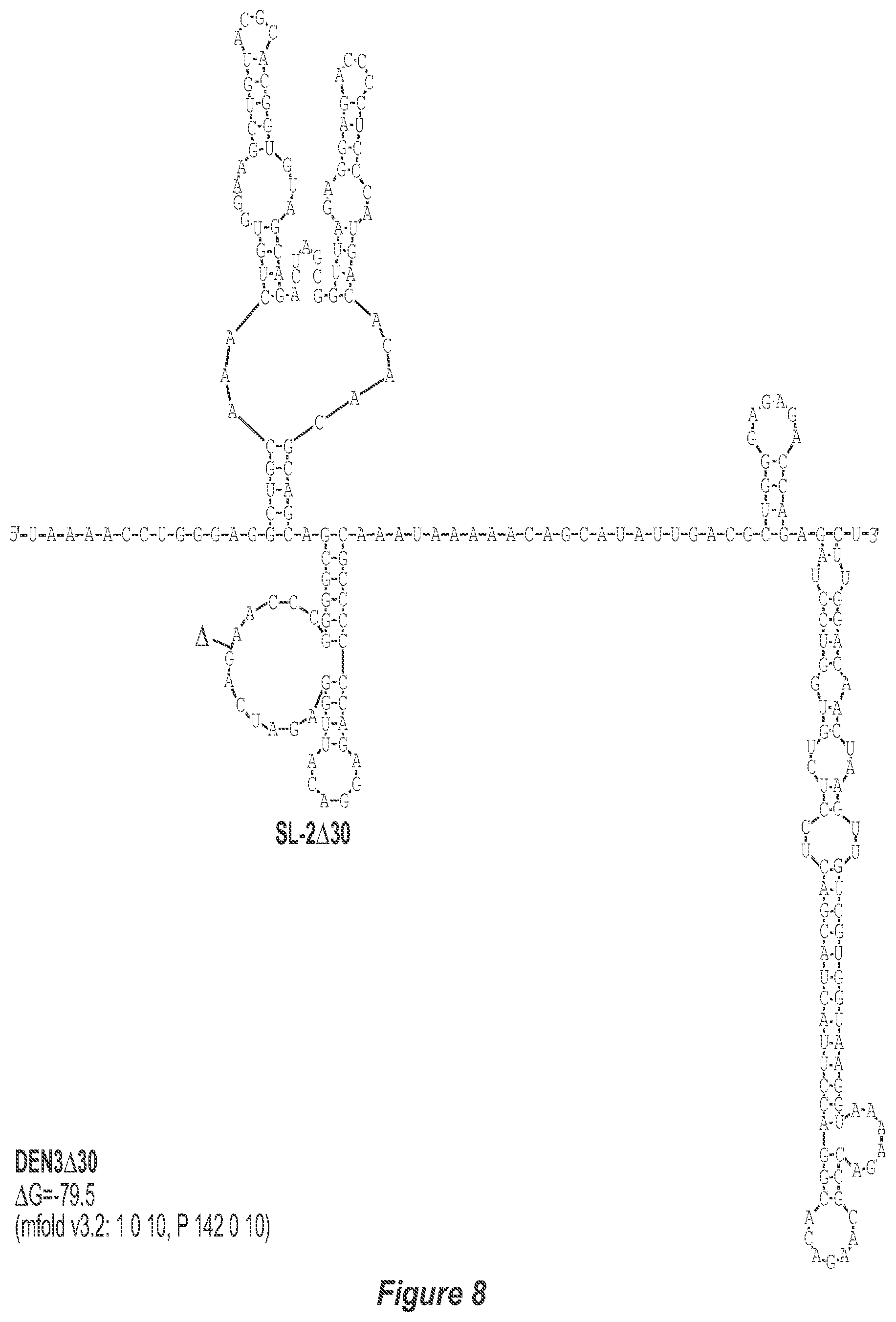
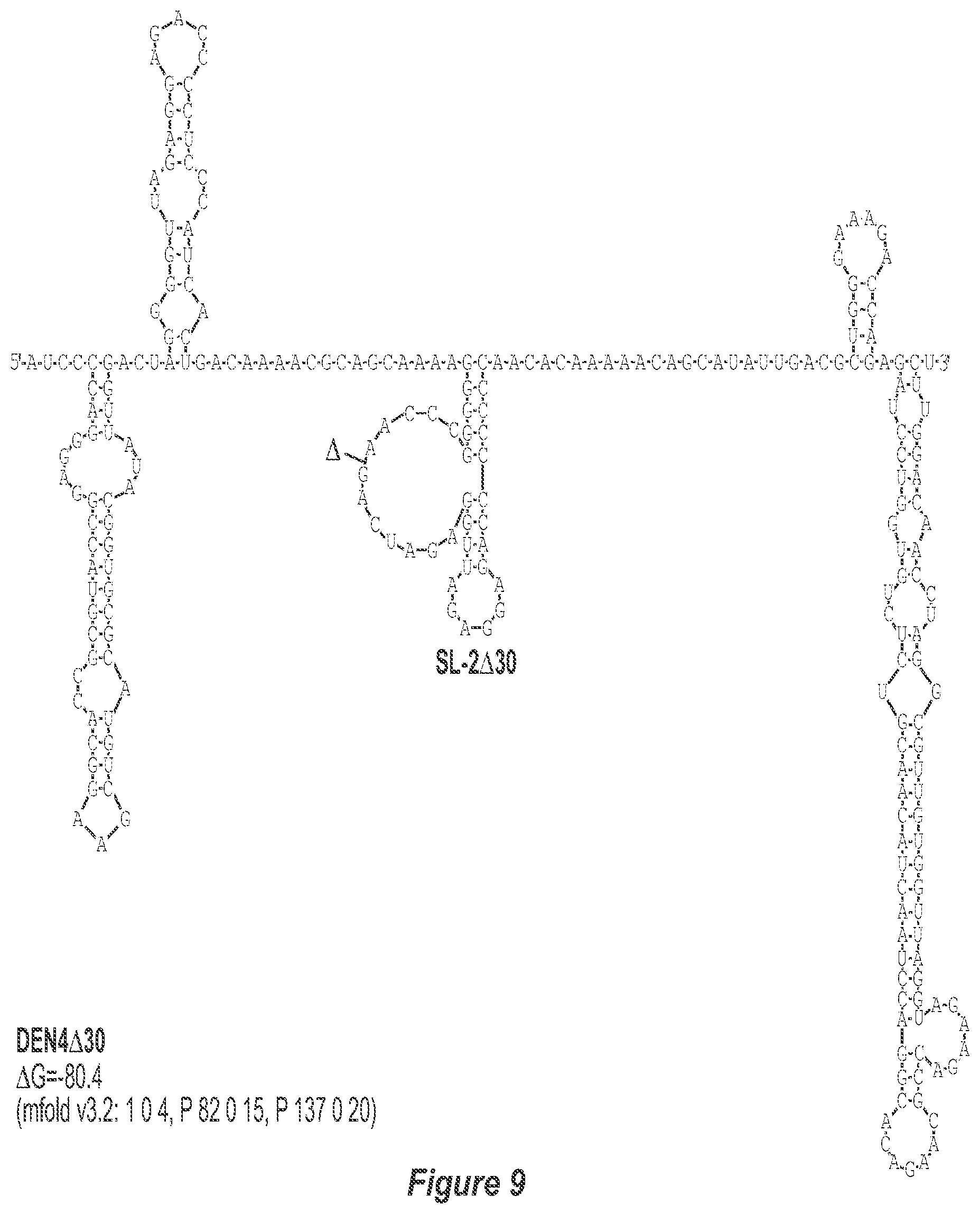
View All Diagrams
| United States Patent Application | 20200318083 |
| Kind Code | A1 |
| Whitehead; Stephen S. ; et al. | October 8, 2020 |
DEVELOPMENT OF DENGUE VIRUS VACCINE COMPONENTS
Abstract
The invention is related to a dengue virus or chimeric dengue virus that contains a mutation in the 3' untranslated region (3'-UTR) comprising a .DELTA.30 mutation that removes the TL-2 homologous structure in each of the dengue virus serotypes 1, 2, 3, and 4, and nucleotides additional to the .DELTA.30 mutation deleted from the 3'-UTR that removes sequence in the 5' direction as far as the 5' boundary of the TL-3 homologous structure in each of the dengue serotypes 1, 2, 3, and 4, or a replacement of the 3'-UTR of a dengue virus of a first serotype with the 3'-UTR of a dengue virus of a second serotype, optionally containing the .DELTA.30 mutation and nucleotides additional to the .DELTA.30 mutation deleted from the 3'-UTR; and immunogenic compositions, methods of inducing an immune response, and methods of producing a dengue virus or chimeric dengue virus.
| Inventors: | Whitehead; Stephen S.; (Bethesda, MD) ; Blaney; Joseph E.; (Gettysburg, PA) ; Murphy; Brian R.; (Bethesda, MD) ; Lai; Ching-Juh; (Bethesda, MA) | ||||||||||
| Applicant: |
|
||||||||||
|---|---|---|---|---|---|---|---|---|---|---|---|
| Assignee: | The Government of the USA as
represented by the Secretary, Dept. of Health and Human
Services Bethesda MD |
||||||||||
| Family ID: | 1000004915705 | ||||||||||
| Appl. No.: | 16/912359 | ||||||||||
| Filed: | June 25, 2020 |
Related U.S. Patent Documents
| Application Number | Filing Date | Patent Number | ||
|---|---|---|---|---|
| 16173217 | Oct 29, 2018 | 10724007 | ||
| 16912359 | ||||
| 14742533 | Jun 17, 2015 | 10160957 | ||
| 16173217 | ||||
| 13692557 | Dec 3, 2012 | 9090873 | ||
| 14742533 | ||||
| 12376756 | Dec 17, 2009 | 8337860 | ||
| PCT/US2007/076004 | Aug 15, 2007 | |||
| 13692557 | ||||
| 60837723 | Aug 15, 2006 | |||
| Current U.S. Class: | 1/1 |
| Current CPC Class: | C07K 14/1825 20130101; C12N 2770/24122 20130101; A61K 2039/5254 20130101; C12N 2770/24162 20130101; C12N 7/00 20130101; Y02A 50/30 20180101; C07K 14/005 20130101; C12N 7/045 20130101 |
| International Class: | C12N 7/04 20060101 C12N007/04; C12N 7/00 20060101 C12N007/00; C07K 14/005 20060101 C07K014/005; C07K 14/18 20060101 C07K014/18 |
Claims
1. An immunogenic composition that is tetravalent for dengue serotypes 1, 2, 3, and 4, wherein the composition comprises a nucleic acid encoding a chimeric dengue virus comprising rDEN3 wherein the 3'-UTR has been replaced with DEN4.DELTA.30, wherein the .DELTA.30 mutation deletes nucleotides from about 172 to 143 of the dengue 4 3'-UTR, designated with the reverse-order numbering system.
2. The immunogenic composition of claim 1, wherein the nucleic acid encoding the chimeric dengue virus comprising rDEN3 further comprises a deletion of nucleotides additional to the .DELTA.30 mutation.
3. The immunogenic composition of claim 2, wherein the deletion of nucleotides additional to the .DELTA.30 mutation comprises: (a) .DELTA.31, corresponding to deleted nucleotides 258-228 of the 3'-UTR of DEN3 Sleman/78 and having the deletion junction -CUGC.DELTA.GACU-; (b) .DELTA.50, corresponding to deleted nucleotides 192-143 of the 3'-UTR of DEN3 Sleman/78 and having the deletion junction -CACA.DELTA.GACU-; (c) .DELTA.61, corresponding to deleted nucleotides 173-113 of the 3'-UTR of DEN3 Sleman/78 and having the deletion junction -CCGA.DELTA.UAAA-; (d) .DELTA.80, corresponding to deleted nucleotides 192-113 of the 3'-UTR of DEN3 Sleman/78 and having the deletion junction -CACA.DELTA.UAAA-; (e) .DELTA.86, corresponding to deleted nucleotides 228-143 of the 3'-UTR of DEN3 Sleman/78 and having the deletion junction -UAGC.DELTA.GACU-; (f) .DELTA.116(A), corresponding to deleted nucleotides 228-113 of the 3'-UTR of DEN3 Sleman/78 and having the deletion junction -UAGC.DELTA.UAAA-; (g) .DELTA.116(B), corresponding to deleted nucleotides 258-143 of the 3'-UTR of DEN3 Sleman/78 and having the deletion junction -CUCC.DELTA.GACU-; and (h) .DELTA.146, corresponding to deleted nucleotides 258-113 of the 3'-UTR of DEN3 Sleman/78 and having the deletion junction -CUGC.DELTA.UAAA-.
4. The immunogenic composition of claim 1, further comprising a nucleic acid encoding a chimeric dengue virus comprising rDEN2/4.DELTA.30, wherein the .DELTA.30 mutation deletes nucleotides from about 172 to 143 of the dengue 4 3'-UTR, designated with the reverse-order numbering system.
5. A method of inducing an immune response to a dengue virus in a patient, comprising administering the immunogenic composition of claim 1 to a patient to induce an immune response to dengue virus.
6. A method of producing a nucleic acid encoding a dengue virus or chimeric dengue virus, comprising introducing a mutation in the 3'-untranslated region (3'-UTR), wherein the mutation is a .DELTA.30 mutation that removes the TL-2 homologous structure in the 3'-UTR and introducing an additional mutation, wherein the additional mutation comprises one or more of: (a) .DELTA.31, corresponding to deleted nucleotides 258-228 of the 3'-UTR of DEN3 Sleman/78 and having the deletion junction -CUGC.DELTA.GACU-; (b) .DELTA.50, corresponding to deleted nucleotides 192-143 of the 3'-UTR of DEN3 Sleman/78 and having the deletion junction -CACA.DELTA.GACU-; (c) .DELTA.61, corresponding to deleted nucleotides 173-113 of the 3'-UTR of DEN3 Sleman/78 and having the deletion junction -CCGA.DELTA.UAAA-; (d) .DELTA.80, corresponding to deleted nucleotides 192-113 of the 3'-UTR of DEN3 Sleman/78 and having the deletion junction -CACA.DELTA.UAAA-; (e) .DELTA.116(A), corresponding to deleted nucleotides 228-113 of the 3'-UTR of DEN3 Sleman/78 and having the deletion junction -UAGC.DELTA.UAAA-; (f) .DELTA.116(B), corresponding to deleted nucleotides 258-143 of the 3'-UTR of DEN3 Sleman/78 and having the deletion junction -CUCC.DELTA.GACU-; and (g) .DELTA.146, corresponding to deleted nucleotides 258-113 of the 3'-UTR of DEN3 Sleman/78 and having the deletion junction -CUGC.DELTA.UAAA-.
Description
CROSS-REFERENCE TO RELATED APPLICATIONS
[0001] This application is a continuation of U.S. patent application Ser. No. 16/173,217, filed Oct. 29, 2018, which is a continuation of U.S. patent application Ser. No. 14/742,533, filed Jun. 17, 2015, which is a continuation of U.S. patent application Ser. No. 13/692,557, filed Dec. 3, 2012, which is a divisional application of U.S. patent application Ser. No. 12/376,756, filed Dec. 17, 2009, which is a National Phase of International Application No. PCT/US2007/076004, filed on Aug. 15, 2007, which claims the benefit of U.S. Provisional Application No. 60/837,723, filed Aug. 15, 2006. The disclosures of each of these applications are hereby expressly incorporated by reference in their entirety.
FIELD OF THE INVENTION
[0002] The invention relates to mutations in the 3' untranslated region of the genome of dengue virus serotypes 1, 2, 3, and 4 that are useful in attenuating the growth characteristics of dengue virus vaccines.
DESCRIPTION OF THE RELATED ART
[0003] There are four serotypes of dengue virus (dengue virus type 1 [DENT], DEN2, DEN3, and DEN4) that annually cause an estimated 50 to 100 million cases of dengue fever and 500,000 cases of the more severe form of dengue virus infection known as dengue hemorrhagic fever/dengue shock syndrome (Gubler, D. J. and M. Meltzer 1999 Adv Virus Res 53:35-70). Dengue virus is widely distributed throughout the tropical and semitropical regions of the world, and the number of dengue virus infections continues to increase due to the expanding range of its Aedes aegypti mosquito vector. A vaccine is not available for the control of dengue disease despite its importance as a reemerging disease. The goal of immunization is to protect against dengue virus disease by the induction of a long-lived neutralizing antibody response against each of the four serotypes. Simultaneous protection against all four serotypes is required, since an increase in disease severity can occur in persons with preexisting antibodies to a heterotypic dengue virus. Such immunization can be achieved economically with a live, attenuated virus vaccine.
[0004] Dengue viruses are positive-sense RNA viruses belonging to the Flavivirus genus. The approximately 1 1,000-base genome contains a single open reading frame encoding a polyprotein which is processed by proteases of both viral and cellular origin into three structural proteins (C, prM, and E) and at least seven nonstructural (NS) proteins. Both ends of the dengue virus genome contain an untranslated region (UTR), and the overall genome organization is 5MJTR-C-prM-E-NSI-NS2A-NS2B-NS3-NS4A-NS4B-NS5-UTR-3'. The 3' UTR is nearly 400 bases in length and is predicted to contain several stem-loop structures conserved among dengue virus serotypes (Brinton, M. A. et al. 1986 Virology 153:113-121, Hahn, C. S. et al. 1987 J Mol Biol 198:33-41, Proutski, V. et al. 1997 Nucleic Acids Res 25:1194-1202, Rauscher, S. et al. 1997 RNA 3:779-791, Shurtleff, A. et al. 2001 Virology 281:75-87). One such stem-loop structure, identified as TL-2 in the proposed secondary structure of the 3' UTR (Proutski, V. et al. 1997 Nucleic Acids Res 25:1194-1202), was previously removed by deletion of 30 nucleotides from the DEN4 genome (3' nucleotides 172 to 143) (Men, R. et al. 1996 J Virol 70:3930-3937) and has subsequently been designated as the .DELTA.30 mutation (Durbin, A. P. et al. 2001 Am J Trop Med Hyg 65:405-413). The resulting virus, rDEN4.DELTA.30, was shown to be attenuated in rhesus monkeys compared to parental viruses containing an intact TL-2 sequence and is attenuated in humans (Durbin, A. P. et al. 2001 Am J Trop Med Hyg 65:405-413).
SUMMARY OF THE INVENTION
[0005] The invention is related to a dengue virus or chimeric dengue virus comprising a mutation in the 3' untranslated region (3'-UTR) selected from the group consisting of: [0006] a .DELTA.30 mutation that removes the TL-2 homologous structure in each of the dengue virus serotypes 1, 2, 3, and 4, and nucleotides additional to the .DELTA.30 mutation deleted from the 3'-UTR that removes sequence in the 5' direction as far as the 5' boundary of the TL-3 homologous structure in each of the dengue virus serotypes 1, 2, 3, and 4; and [0007] (b) a replacement of the 3'-UTR of a dengue virus of a first serotype with the 3'-UTR of a dengue virus of a second serotype, optionally containing the .DELTA.30 mutation and nucleotides additional to the .DELTA.30 mutation deleted from the 3'-UTR;
[0008] and immunogenic compositions, methods of inducing an immune response, and methods of producing a dengue virus or chimeric dengue virus.
BRIEF DESCRIPTION OF THE DRAWINGS
[0009] FIG. 1. Two approaches to attenuate dengue viruses. A) (a-c) Deletion of additional nucleotides from the 3'-UTR (DEN3 wt Sleman/78, SEQ ID NO: 1). B) Replacement of the 3'-UTR of a dengue virus of a first serotype with the 3'-UTR of a dengue virus of a second serotype.
[0010] FIG. 1a is a magnified version of FIG. 1 in the portion designated as A(a).
[0011] FIG. 1b is a magnified version of FIG. 1 in the portion designated as A(b).
[0012] FIG. 1c is a magnified version of FIG. 1 in the portion designated as A(c).
[0013] FIG. 2. Predicted secondary structure of the TL-1, TL-2 and TL-3 region of the 3'-UTR of each DEN serotype. The GenBank accession number of the sequence used for construction of each secondary structure model is indicated. Only the last 278, 281, 276 and 281 nucleotides of DEN1, DEN2, DEN3, and DEN4, respectively, which comprise TL-1, TL-2 and TL-3, are used to avoid circularization of the structure and subsequent misfolding of known and experimentally-verified structural elements. The mfold program contraints specific for each structure model are indicated. Nucleotides that border the principle deletions are circled and numbered, with nucleotide numbering beginning at the 3' genome end (reverse-direction numbering system). The nucleotide sequence shown in FIG. 2:--SEQ ID NO: 2.
[0014] FIG. 3. Predicted secondary structure of the TL-1, TL-2 and TL-3 region of the 3'-UTR of each DEN serotype. The GenBank accession number of the sequence used for construction of each secondary structure model is indicated. Only the last 278, 281, 276 and 281 nucleotides of DEN1, DEN2, DEN3, and DEN4, respectively, which comprise TL-1, TL-2 and TL-3, are used to avoid circularization of the structure and subsequent misfolding of known and experimentally-verified structural elements. The refold program contraints specific for each structure model are indicated. Nucleotides that border the principle deletions are circled and numbered, with nucleotide numbering beginning at the 3' genome end (reverse-direction numbering system). The nucleotide sequence shown in FIG. 3:--SEQ ID NO: 3.
[0015] FIG. 4. Predicted secondary structure of the TL-1, TL-2 and TL-3 region of the 3'-UTR of each DEN serotype. The GenBank accession number of the sequence used for construction of each secondary structure model is indicated. Only the last 278, 281, 276 and 281 nucleotides of DEN1, DEN2, DEN3, and DEN4, respectively, which comprise TL-1, TL-2 and TL-3, are used to avoid circularization of the structure and subsequent misfolding of known and experimentally-verified structural elements. The mfold program contraints specific for each structure model are indicated. Nucleotides that border the principle deletions are circled and numbered, with nucleotide numbering beginning at the 3' genome end (reverse-direction numbering system). The nucleotide sequence shown in FIG. 4:--SEQ ID NO: 4.
[0016] FIG. 5. Predicted secondary structure of the TL-1, TL-2 and TL-3 region of the 3'-UTR of each DEN serotype. The GenBank accession number of the sequence used for construction of each secondary structure model is indicated. Only the last 278, 281, 276 and 281 nucleotides of DEN1, DEN2, DEN3, and DEN4, respectively, which comprise TL-1, TL-2 and TL-3, are used to avoid circularization of the structure and subsequent misfolding of known and experimentally-verified structural elements. The infold program contraints specific for each structure model are indicated. Nucleotides that border the principle deletions are circled and numbered, with nucleotide numbering beginning at the 3' genome end (reverse-direction numbering system). The nucleotide sequence shown in FIG. 5:--SEQ ID NO: 5.
[0017] FIG. 6. .DELTA.30 deletion mutation depicted for each of the dengue virus serotypes DEN1, DEN2, DEN3 and DEN4. The .DELTA.30 mutation deletes nt 174 to 145 of DEN1, nt 173 to 144 of DEN2, nt 173 to 143 of DEN3, and nt 172 to 143 of DEN4, with reverse-direction numbering system. The deleted region is indicated by the .DELTA. symbol. The nucleotide sequence shown in FIG. 6:--SEQ ID NO: 6.
[0018] FIG. 7. .DELTA.30 deletion mutation depicted for each of the dengue virus serotypes DEN1, DEN2, DEN3 and DEN4. The .DELTA.30 mutation deletes nt 174 to 145 of DEN1, nt 173 to 144 of DEN2, nt 173 to 143 of DEN3, and nt 172 to 143 of DEN4, with reverse-direction numbering system. The deleted region is indicated by the .DELTA. symbol. The nucleotide sequence shown in FIG. 7:--SEQ ID NO: 7.
[0019] FIG. 8. .DELTA.30 deletion mutation depicted for each of the dengue virus serotypes DEN1, DEN2, DEN3 and DEN4. The .DELTA.30 mutation deletes nt 174 to 145 of DEN1, nt 173 to 144 of DEN2, nt 173 to 143 of DEN3, and nt 172 to 143 of DEN4, with reverse-direction numbering system. The deleted region is indicated by the .DELTA. symbol. The nucleotide sequence shown in FIG. 8:--SEQ ID NO: 8.
[0020] FIG. 9. .DELTA.30 deletion mutation depicted for each of the dengue virus serotypes DEN1, DEN2, DEN3 and DEN4. The .DELTA.30 mutation. deletes nt 174 to 145 of DEN1, nt 173 to 144 of DEN2, nt 173 to 143 of DEN3, and nt 172 to 143 of DEN4, with reverse-direction numbering system. The deleted region is indicated by the .DELTA. symbol. The nucleotide sequence shown in FIG. 9:--SEQ ID NO: 9.
[0021] FIG. 10. .DELTA.30/31 deletion mutation depicted for each of the dengue virus serotypes DEN1, DEN2, DEN3 and DEN4. In addition to the deletion of the nucleotides comprising the .DELTA.30 mutation, the .DELTA.31 mutation deletes nt 258 to 228 of DEN1, DEN2, DEN3, and DEN4, with reverse-direction numbering system. The deleted region is indicated by the .DELTA. symbol. The nucleotide sequence shown in FIG. 10:--SEQ ID NO: 10.
[0022] FIG. 11. .DELTA.30/31 deletion mutation depicted for each of the dengue virus serotypes DEN1, DEN2, DEN3 and DEN4. In addition to the deletion of the nucleotides comprising the .DELTA.30 mutation, the .DELTA.31 mutation deletes nt 258 to 228 of DEN1, DEN2, DEN3, and DEN4, with reverse-direction numbering system. The deleted region is indicated by the .DELTA. symbol. The nucleotide sequence shown in FIG. 11:--SEQ ID NO: 11.
[0023] FIG. 12. .DELTA.30/31 deletion mutation depicted for each of the dengue virus serotypes DEN1, DEN2, DEN3 and DEN4. In addition to the deletion of the nucleotides comprising the .DELTA.30 mutation, the .DELTA.31 mutation deletes nt 258 to 228 of DEN1, DEN2, DEN3, and DEN4, with reverse-direction numbering system. The deleted region is indicated by the .DELTA. symbol. The nucleotide sequence shown in FIG. 12:--SEQ ID NO: 12.
[0024] FIG. 13. A30/31 deletion mutation depicted for each of the dengue virus serotypes DEN1, DEN2, DEN3 and DEN4. In addition to the deletion of the nucleotides comprising the .DELTA.30 mutation, the .DELTA.31 mutation deletes nt 258 to 228 of DEN1, DEN2, DEN3, and DEN4, with reverse-direction numbering system. The deleted region is indicated by the .DELTA. symbol. The nucleotide sequence shown in FIG. 3:--SEQ ID NO: 13.
[0025] FIG. 14. .DELTA.86 deletion mutation depicted for each of the dengue virus serotypes DEN1, DEN2, DEN3 and DEN4. The .DELTA.86 mutation deletes nt 228 to 145 of DEN1, nt 228 to 144 of DEN2, nt 228 to 143 of DEN3, and nt 228 to 143 of DEN4, with reverse-direction numbering system. The deleted region is indicated by the .DELTA. symbol. The nucleotide sequence shown in FIG. 14:--SEQ ID NO: 14.
[0026] FIG. 15. .DELTA.86 deletion mutation depicted for each of the dengue virus serotypes DEN1, DEN2, DEN3 and DEN4. The .DELTA.86 mutation deletes nt 228 to 145 of DEN1, nt 228 to 144 of DEN2, nt 228 to 143 of DEN3, and nt 228 to 143 of DEN4, with reverse-direction numbering system. The deleted region is indicated by the .DELTA. symbol. The nucleotide sequence shown in FIG. 15:--SEQ ID NO: 15.
[0027] FIG. 16. .DELTA.86 deletion mutation depicted for each of the dengue virus serotypes DEN1, DEN2, DEN3 and DEN4. The .DELTA.86 mutation deletes nt 228 to 145 of DEN1, nt 228 to 144 of DEN2, nt 228 to 143 of DEN3, and nt 228 to 143 of DEN4, with reverse-direction numbering system. The deleted region is indicated by the .DELTA. symbol. The nucleotide sequence shown in FIG. 16:--SEQ ID NO: 16.
[0028] FIG. 17. .DELTA.86 deletion mutation depicted for each of the dengue virus serotypes DEN1, DEN2, DEN3 and DEN4. The .DELTA.86 mutation deletes nt 228 to 145 of DEN1, nt 228 to 144 of DEN2, nt 228 to 143 of DEN3, and nt 228 to 143 of DEN4, with reverse-direction numbering system. The deleted region is indicated by the .DELTA. symbol. The nucleotide sequence shown in FIG. 17: SEQ ID NO: 17.
[0029] FIG. 18. Chimerization of rDEN3 with the rDEN4 or rDEN4 .DELTA.3'-UTR. A) recombinant 3'-UTR chimeric dengue viruses were constructed by replacing the 3'-UTR of rDEN3 with regions derived from either rDEN4 or rDEN4 .DELTA.30. The relative location of the .DELTA.30 mutation in the 3'-UTR is indicated by an arrow. The junctions between the ORF and UTR for rDEN3 and rDEN4 are indicated as junctions 1 and 2, respectively. Intertypic junction 3 is also indicated for the resulting chimeric viruses. B) nucleotide and amino acid sequence of the junction regions are shown. For junction 3, nucleotide substitutions used to introduce a unique hpai restriction enzyme recognition site are shown in lower case. Junction 1--SEQ ID NOS: 18 (nucleotide) and 19 (amino acid); junction 2--SEQ ID NOS: 20 (nucleotide) and 21 (amino acid); junction 3--SEQ ID NOS: 22 (nucleotide) and 23 (amino acid).
[0030] FIG. 19. Replication in vero cells and C6/36 cells. Four mutant viruses were compared to wild type rDEN3 for replication in vero cells and C6/36 cells. 75 cm.sup.2 flasks of confluent cells were infected at a multiplicity of infection of 0.01. Aliquots of 0.5 ml were removed from flasks daily for seven days. After addition of spg to a concentration of 1.times., samples were frozen on dry ice and stored at -80.degree. C. Virus titer was determined by plaque assay on vero cells for all samples. The limit of detection is 1.0 log.sub.10pfu/ml.
DETAILED DESCRIPTION OF THE PREFERRED EMBODIMENT
Definitions
[0031] Unless defined otherwise, technical and scientific terms used herein have the same meaning as commonly understood by one of ordinary skill in the art to which this invention belongs. See, e.g., Singleton P and Sainsbury D., Dictionary of Microbiology and Molecular Biology 3rd ed., J. Wiley & Sons, Chichester, New York, 2001, and Fields Virology 4th ed., Knipe D. M. and Howley P. M. eds, Lippincott Williams & Wilkins, Philadelphia 2001.
[0032] The term "about" means within 1, 2, or 3 nucleotides.
Mutant Dengue Viruses and Chimeric Dengue Viruses
[0033] A goal of the invention is to develop a set of type-specific, live attenuated dengue vaccine components that can be formulated into a safe, effective, and economical tetravalent dengue vaccine. The .DELTA.30 mutation attenuates DEN4 in rhesus monkeys (Men, R. et al. 1996 J Virol 70:3930-3937)). The .DELTA.30 mutation removes a homologous structure (TL-2) in each of the dengue virus serotypes 1, 2, 3, and 4 (FIGS. 2-5). However, the .DELTA.30 mutation was found to not attenuate DEN 3 in rhesus monkeys.
[0034] An embodiment of the invention provides dengue viruses and chimeric dengue viruses having one or more mutations that result in attenuation, methods of making such dengue viruses, and methods for using these dengue viruses to prevent or treat dengue virus infection. The mutation (or mutations) in the dengue virus of the invention is present in the 3' untranslated region (3'-UTR) formed by the most downstream approximately 384 nucleotides of the viral RNA, which have been shown to play a role in determining attenuation. The viruses and methods of the invention are described further, as follows.
[0035] One example of a dengue virus that can be used in the invention is the serotype 3, Sleman/78 strain. The applicability of the invention to all members of the dengue virus taxonomic group is inferred by the observation that the properties of other dengue virus strains are similar to that of any one dengue virus strain. Dengue viruses have been grouped into four serotypes (DEN1, DEN2, DEN3 and DEN4). Numerous strains have been identified for each of the four serotypes. The complete genomic sequences of various dengue virus strains are provided as Genbank accession numbers in Table A.
TABLE-US-00001 TABLE A Examples of Dengue Virus Strains Serotype Strain Accession No. 1 02-20 AB178040 1 16007 AF180817 1 16007 PDK-13 AF180818 1 259par00 AF514883 1 280par00 AF514878 1 293arg00 AY206457 1 295arg00 AF514885 1 297arg00 AF514889 1 301arg00 AF514876 1 98901518 AB189120 1 98901530 AB189121 1 A88 AB074761 1 Abidjan AF798807 1 ARG0028 AY277665 1 ARG0048 AY277666 1 ARG9920 AY277664 1 BR-90 AF226685 1 BR-01-MR AF513110 1 BR-97-111 AF311956 1 BR-97-233 AF311958 1 BR-97-409 AF311957 1 Cambodia AF309641 1 FGA-89 AF226687 1 FGA-NA d1d AF226686 1 Fj231-04 DQ193572 1 GD05-99 AY376738 1 GD23-95 AY373427 1 GZ-80 AF350498 1 D1-hu-Yap-NIID27-2004 AB204803 1 D1-H-IMTSSA-98-606 AF298808 1 Mochizuki AB074760 1 D1.Myanmar.059-01 AY708047 1 D1.Myanmar.194-01 AY713474 1 D1.Myanmar.206-01 AY713475 1 D1.Myanmar.23819-96 AY722802 1 D1.Myanmar.305-01 AY713476 1 D1.Myanmar.31459-98 AY726555 1 D1.Myanmar.31987-98 AY726554 1 D1.Myanmar.32514-98 AY722803 1 D1.Myanmar.37726-01 AY726549 1 D1.Myanmar.38862-01 AY726550 1 D1.Myanmar.40553-71 AY713473 1 D1.Myanmar.40568-76 AY722801 1 D1.Myanmar.44168-01 AY726551 1 D1.Myanmar.44988-02 AY726552 1 D1.Myanmar.49440-02 AY726553 1 rWestern Pacific-delta30 AY145123 1 Western Pacific rDEN1mutF AY145122 1 S275-90 A75711 1 D1-hu-Seychelles-NIID41-2003 AB195673 1 Singapore 8114-93 AY762084 1 Singapore S275-90 M87512 1 ThD1_0008_81 AY732483 1 ThD1_0049_01 AY732482 1 ThD1_0081_82 AY732481 1 ThD1_0097_94 AY732480 1 ThD1_0102_01 AY732479 1 ThD1_0323_91 AY732478 1 ThD1_0336_91 AY732477 1 ThD1_0442_80 AY732476 1 ThD1_0488_94 AY732475 1 ThD1_0673_80 AY732474 1 Recombinant Western Pacific AY145121 1 Nauru Island Western Pacific 45AZ5 NC_001477 1 Nauru Island Western Pacific Bethesda U88535 1 Nauru Island Western Pacific 45AZ5-PDK27 U88537 2 131 AF100469 2 16681-PDK53 M84728 2 16681 Blok M84727 2 16681 Kinney U87411 2 43 AF204178 2 44 AF204177 2 98900663 AB189122 2 98900665 AB189123 2 98900666 AB189124 2 BA05i AY858035 2 Bangkok 1974 AJ487271 2 BR64022 AF489932 2 C0166 AF100463 2 C0167 AF100464 2 C0371 AF100461 2 C0390 AF100462 2 China 04 AF119661 2 Cuba115-97 AY702036 2 Cuba13-97 AY702034 2 Cuba165-97 AY702038 2 Cuba205-97 AY702039 2 Cuba58-97 AY702035 2 Cuba89-97 AY702037 2 DR23-01 AB122020 2 DR31-01 AB122021 2 DR59-01 AB122022 2 FJ-10 AF276619 2 FJ11-99 AF359579 2 I348600 AY702040 2 IQT1797 AF100467 2 IQT2913 AF100468 2 Jamaica-N.1409 M20558 2 K0008 AF100459 2 K0010 AF100460 2 Mara4 AF100466 2 DEN2-H-IMTSSA-MART-98-703 AF208496 2 New Guinea C AF038403 2 New Guinea C-PUO-218 hybrid AF038402 2 New Guinea-C M29095 2 PDK-53 U87412 2 S1 vaccine NC_001474 2 TB16i AY858036 2 ThD2_0017_98 DQ181799 2 ThD2_0026_88 DQ181802 2 ThD2_0038_74 DQ181806 2 ThD2_0055_99 DQ181798 2 ThD2_0078_01 DQ181797 2 ThD2_0168_79 DQ181805 2 ThD2_0263_95 DQ181800 2 ThD2_0284_90 DQ181801 2 ThD2_0433_85 DQ181803 2 ThD2_0498_84 DQ181804 2 ThNH-28-93 AF022435 2 ThNH29-93 AF169678 2 ThNH36-93 AF169679 2 ThNH45-93 AF169680 2 ThNH-52-93 AF022436 2 ThNH54-93 AF169682 2 ThNH55-93 AF169681 2 ThNH62-93 AF169683 2 ThNH63-93 AF169684 2 ThNH69-93 AF169685 2 ThNH73-93 AF169686 2 ThNH76-93 AF169687 2 ThNH81-93 AF169688 2 ThNH-p36-93 AF022441 2 ThNH-7-93 AF022434 2 ThNH-p11-93 AF022437 2 ThNH-p12-93 AF022438 2 ThNH-p14-93 AF022439 2 ThNH-p16-93 AF022440 2 Tonga-74 AY744147 2 TSV01 AY037116 2 Taiwan-1008DHF AY776328 2 Ven2 AF100465 3 D3-H-IMTSSA-MART-1999-1243 AY099337 3 D3-H-IMTSSA-SRI-2000-1266 AY099336 3 80-2 AF317645 3 98901403 AB189125 3 98901437 AB189126 3 98901517 AB189127 3 98902890 AB189128 3 BA51 AY858037 3 BDH02-1 AY496871 3 BDH02-3 AY496873 3 BDH02-4 AY496874 3 BDH02-7 AY496877 3 BR74886-02 AY679147 3 C0331-94 AY876494 3 C0360-94 AY923865 3 den3_88 AY858038 3 den3_98 AY858039 3 FW01 AY858040 3 FW06 AY858041 3 H87 NC_001475 3 D3-Hu-TL018NIID-2005 AB214879 3 D3-Hu-TL029NIID-2005 AB214880 3 D3-Hu-TL109NIID-2005 AB214881 3 D3-Hu-TL129NIID-2005 AB214882 3 InJ_16_82 DQ401690 3 KJ30i AY858042 3 KJ46 AY858043 3 KJ71 AY858044 3 mutant BDH02_01 DQ401689 3 mutant BDH02_03 DQ401691 3 mutant BDH02_04 DQ401692 3 mutant BDH02_07 DQ401693 3 mutant InJ_I6_82 DQ401694 3 mutant PhMH_J1_97 DQ401695 3 PF89-27643 AY744677 3 PF89-320219 AY744678 3 PF90-3050 AY744679 3 PF90-3056 AY744680 3 PF90-6056 AY744681 3 PF92-2956 AY744682 3 PF92-2986 AY744683 3 PH86 AY858045 3 PhMH-J1-97 AY496879 3 PI64 AY858046 3 Singapore AY662691 3 Singapore 8120-95 AY766104 3 Sleman-78 AY648961 3 TB16 AY858047 3 TB55i AY858048 3 ThD3_0007_87 AY676353 3 ThD3_0010_87 AY676353 3 ThD3_0055_93 AY676351 3 ThD3_0104_93 AY676350 3 ThD3_1283_98 AY676349 3 ThD3_1687_98 AY676348 3 PF92-4190 AY744684 3 PF94-136116 AY744685 3 Taiwan-739079A AY776329 4 2A AF375822 4 Recombinant clone rDEN4 AF326825 4 2Adel30 AF326826 4 814669 AF326573 4 B5 AF289029 4 rDEN4del30 AF326827 4 H241 AY947539 4 rDEN4 NC_002640 4 Singapore 8976-95 AY762085 4 SW38i AY858050 4 ThD4_0017_97 AY618989 4 ThD4_0087_77 AY618991 4 ThD4_0348_91 AY618990 4 ThD4_0476_97 AY618988 4 ThD4_0485_01 AY618992 4 ThD4_0734_00 AY618993 4 Taiwan-2K0713 AY776330 4 Unknown M14931
[0036] Mutations can be made in the 3'-UTR of a wild type infectious clone, e.g., dengue virus serotype 3, strain Sleman/78 or an infectious clone of another wild type, virulent dengue virus, and the mutants can then be tested in an animal model system (e.g., in mouse and/or monkey model systems) to identify sites that cause attenuation. Attenuation is judged by, for example, detection of decreased vireinia. One or more additional mutations found to attenuate the wild-type virus are optionally introduced into a wild type dengue virus, and these mutants are tested in an animal model system (e.g., in a mouse and/or a monkey model system) to determine whether the resulting mutants are attenuated. Mutants that are found to be attenuated can then be used as new vaccine strains that have increased safety, due to attenuation.
[0037] In addition to the viruses listed above, dengue viruses including chimeric dengue viruses that include one or more attenuating mutations are included in the invention. These chimeras can consist of a dengue virus of a first serotype (i.e., a background dengue virus) in which a structural protein (or proteins) has been replaced with a corresponding structural protein (or proteins) of a dengue virus of a second serotype. For example, the chimeras can consist of a background dengue virus in which the prM and E proteins of the dengue virus of the first serotype have been replaced with the prM and E proteins of the dengue virus of the second serotype. The chimeric viruses can be made from any combination of dengue viruses of different serotypes. The dengue s against which immunity is sought is the source of the inserted structural protein(s).
[0038] As is noted above, mutations that are included in the viruses of the present invention are attenuating. These mutations are present in the dengue virus 3'-UTR structure to attenuate the virus. Mutations can be made in the 3'-UTR using standard methods, such as site-directed mutagenesis. One example of the type of mutation present in the viruses of the invention is substitutions, but other types of mutations, such as deletions and insertions, can be used as well. In addition, as is noted above, the mutations can be present singly or in the context of one or more additional mutations.
[0039] Referring to FIG. 1, two approaches were taken to attenuate dengue virus. In one aspect, nucleotides additional to the .DELTA.30 mutation were deleted from the 3'-UTR. In another aspect, the 3'-UTR of a dengue virus of a first serotype was replaced with the 3'-UTR from a dengue virus of a second serotype (optionally containing the .DELTA.30 mutation and nucleotides additional to the .DELTA.30 mutation deleted from the 3'-UTR).
Deletion of Nucleotides Additional to the .DELTA.30 Mutation from the 3'-UTR
[0040] Referring to FIGS. 2-5, using the first approach, the 3'-UTR of dengue viruses contain various conserved sequence motifs. The sequence of the DEN4 3'-UTR is illustrated in FIG. 5. The genome of DEN4 strain 814669 contains 10,646 nucleotides, of which the last 384 nt at the 3' terminus are untranslated (non-coding). The locations of various sequence components in this region are designated with the reverse-direction numbering system. These sequences include the 3' distal secondary structure (nt 1 to 93), predicted to form stem-loop 1 (SL-1), which contains terminal loop 1 (TL-1). Nucleotides 117-183 form stem-loop 2 (SL-2) which contains TL-2. Nucleotides 201-277 form a pair of stem-loops (SL-3) which in part contains TL-3. Although the primary sequence of stem-loop 1 differs slightly among the dengue serotypes, the secondary structure is strictly conserved (compare FIGS. 2-5). Although the nucleotide spacing between SL-2 and neighboring SL-1 and SL-3 differ among the dengue virus serotypes, the overall structure of SL-2 is well-conserved. In addition, the exposed 9 nucleotides that comprise TL-2 are identical within all 4 dengue serotypes. It is TL-2 and its supporting stem structure that are removed by the .DELTA.30 mutation (about nt 143-172). Removal of these 30 nucleotides results in formation of a new predicted structural element (SL-2.DELTA.30) which has a primary sequence and secondary structure which is identical for each of the dengue virus serotypes (compare FIGS. 6-9).
[0041] FIGS. 10-13 illustrate the approach where nucleotides additional to the .DELTA.30 mutation are deleted from the 3'-UTR. The .DELTA.30 mutation removes the TL-2 homologous structure in each of the dengue virus serotypes 1, 2, 3, and 4. The approach where nucleotides additional to the .DELTA.30 mutation are deleted from the 3'-UTR removes the TL-2 homologous structure and sequence up to and optionally including the TL-3 homologous structure so that the deletion extends as far as the 5' boundary of the TL-3 homologous structure in each of the dengue virus serotypes 1, 2, 3, and 4. In the approach illustrated in FIGS. 10-14, an additional deletion of about 31 nucleotides from TL-3 results in formation of a new predicted structural element (SL-3.DELTA.31).
[0042] Referring to FIGS. 14-17, the .DELTA.86 mutation removes the TL-2 homologous structure and removes sequence up to the TL-3 homologous structure in each of the dengue virus serotypes DEN1, DEN2, DEN3 and DEN4. This deletion results in the formation of a new predicted structural element (SL: 2.DELTA.86).
[0043] In some embodiments that involve deletion of nucleotides additional to the .DELTA.30) mutation, nucleic acid deletions are made to the 3'-UTR structure of the dengue virus genome to attenuate the virus while maintaining its immunogenicity. The deletions include the .DELTA.30 deletion (nt 173-143 of the serotype 3 Sleman/78 strain in an exemplary manner or corresponding thereto in other strains of DEN1, DEN2, DEN3, or DEN4; numbering is from the 3' end of the viral genome) in addition to deletion of additional 3'-UTR sequence that is contiguous or non-contiguous to the .DELTA.30 deletion. The .DELTA.30 deletion corresponds to the TL-2 structure of the 3'-UTR. One type of embodiment, termed rDEN1.DELTA.30/31, rDEN2.DELTA.30/31, rDEN3.DELTA.30/31, or rDEN4.DELTA.30/31 includes the original .DELTA.30 deletion and a non-contiguous 31 nt deletion that removes both the original TL-2 and TL-3 structures. Another type of embodiment, termed rDEN1.DELTA.61, rDEN2.times.61, rDEN3.DELTA.61, or rDEN4.DELTA.61 includes the .DELTA.30 deletion and deletion of 31 contiguous nucleotides extending 3' from the .DELTA.30 deletion. Another type of embodiment, termed rDEN1.DELTA.86, rDEN2.DELTA.86, rDEN3.times.86, or rDEN4.DELTA.86, includes the .DELTA.30 deletion and deletion of 56 contiguous nucleotides extending 5' from the .DELTA.30 deletion. For DEN3, a complete list of mutant viruses constructed to contain 3'-UTR deletion mutations is presented below in Table 2.
Replacement of the 3'-UTR of a Dengue Virus of a First Serotype with the 3'-UTR from a Dengue Virus of a Second Serotype
[0044] Using the second approach, the 3'-UTR of rDEN3 may be replaced with the 3'-UTR of rDEN4, optionally containing the .DELTA.30 mutation and nucleotides additional to the .DELTA.30 mutation deleted from the 3'-UTR. Other examples include replacement of the 3'-UTR of rDEN3 with the 3'-UTR of dengue virus serotypes 1 and 2, optionally containing the .DELTA.30 mutation and nucleotides additional to the .DELTA.30 mutation deleted from the 3'-UTR. Other examples include: replacement of the 3'-UTR of rDEN1 with the 3'-UTR of dengue virus serotypes 2, 3, and 4, optionally containing the .DELTA.30 mutation and nucleotides additional to the .DELTA.30 mutation deleted from the 3'-UTR; replacement of the 3'-UTR of rDEN2 with the 3'-UTR of dengue virus serotypes 1, 3, and 4, optionally containing the .DELTA.30 mutation and nucleotides additional to the .DELTA.30 mutation deleted from the 3'-UTR; and, replacement of the 3'-UTR of rDEN4 with the 3'-UTR of dengue virus serotypes 1, 2, and 3, optionally containing the .DELTA.30 mutation and nucleotides additional to the .DELTA.30 mutation deleted from the 3'-UTR.
[0045] Embodiments that involve replacement of the 3'-UTR of a dengue virus of a first serotype with the 3'-UTR of dengue virus of a second serotype include:
[0046] a) rDEN1-3'D2, rDEN1-3D2x, rDEN1-3'D3, rDEN1-3'D3x, rDEN1-3'D4, rDEN1-3'D4x; [0047] rDEN1/2-3'D1, rDEN1/2-3'D1x, rDEN1/2-3'D3, rDEN1/2-3'D3x, rDEN1/2-3'D4, rDEN1/2-3'D4x; [0048] rDEN1/3-3'D1, rDEN1/3-3'D1x, rDEN1/3-3'D2, rDEN1/3-3'D2x, rDEN1/3-3'D4, rDEN1/3-3'D4x; [0049] rDEN1/4-3'D1, rDEN1/4-3'D1x, rDEN1/4-3'D2, rDEN1/4-3'D2x, rDEN1/4-3'D3, rDEN3/4-3'D3x;
[0050] b) rDEN2-3'D1, rDEN2-3'D1x, rDEN2-3'D3, rDEN2-3'D3x, rDEN2-3'D4, rDEN2-3'D4x; [0051] rDEN2/1-3'D2, rDEN2/1-3'D2x, rDEN2/1-3'D3, rDEN2/1-3'D3x, rDEN2/1-3'D4, rDEN2/1-3'D4x; [0052] rDEN2/3-3'D1, rDEN2/3-3'D1x, rDEN2/3-3'D2, rDEN2/3-3'D2x, rDEN2/3-3'D4, rDEN2/3-3'D4x; [0053] rDEN2/4-3'D1, rDEN2/4-3'D1x, rDEN2/4-3'D2, rDEN2/4-3'D2x, rDEN2/4-3'D3, rDEN2/4-3'D3x;
[0054] c) rDEN3-3'D1, rDEN3-3'D1x, rDEN3-3'D2, rDEN3-3'D2x, rDEN3-3'D4, rDEN3-3'D4x; [0055] rDEN3/1-3'D2, rDEN3/1-3'D2x, rDEN3/1-3'D3, rDEN3/1-3'D3x, rDEN3/1-3'D4, rDEN3/1-3'D4x; [0056] rDEN3/2-3'D1, rDEN3/2-3'D1x, rDEN3/2-3'D3, rDEN3/2-3'D3x, rDEN3/2-3'D4, rDEN3/2-3'D4x; [0057] rDEN3/4-3'D1, rDEN3/4-3'D1x, rDEN3/4-3'D2, rDEN3/4-3'D2x, rDEN3/4-3D3, rDEN3/4-3'D3x; and
[0058] d) rDEN4-3'D1, rDEN4-3'D1x, rDEN4-3'D2, rDEN4-3'D2x, rDEN4-3'D3, rDEN4-3'D3x; [0059] rDEN4/1-3'D2, rDEN4/1-3'D2x, rDEN4/1-3'D3, rDEN4/1 -3'D3x, rDEN4/1-3'D4, rDEN4/1-3D4x; [0060] rDEN4/2-3'D1, rDEN4/2-3'D1x, rDEN4/2-3'D3, rDEN4/2-3'D3x, rDEN4/2-3'D4, rDEN4/2-3'D4x; [0061] rDEN4/3-3'D1, rDEN4/3-3'D1x, rDEN4/3-3'D2, rDEN4/3-3'D2x, rDEN4/3-3'D4, rDEN4/3-3'D4x; [0062] where x is a mutation listed in Table 2.
Method of Making and Using Dengue or Chimeric Dengue Viruses
[0063] The viruses (including chimeric viruses) of the present invention can be made using standard methods in the art. For example, an RNA molecule corresponding to the genome of a virus can be introduced into host cells, e.g., Vero cells, from which (or the supernatants of which) progeny virus can then be purified. In this method, a nucleic acid molecule (e.g., an RNA molecule) corresponding to the genome of a virus is introduced into the host cells, virus is harvested from the medium in which the cells have been cultured, and the virus is formulated for the purposes of vaccination.
[0064] The viruses of the invention can be administered as primary prophylactic agents in adults or children at risk of infection, or can be used as secondary agents for treating infected patients. For example, in the case of DEN virus and chimeric DEN viruses, the vaccines can be used in adults or children at risk of DEN virus infection, or can be used as secondary agents for treating DEN virus-infected patients. Examples of patients who can be treated using the DEN virus-related vaccines and methods of the invention include (i) children in areas in which DEN virus is endemic, (ii) foreign travelers, (iii) military personnel, and (iv) patients in areas of a DEN virus epidemic. Moreover, inhabitants of regions into which the disease has been observed to be expanding (e.g., beyond Sri Lanka, East Africa and Latin America), or regions in which it may be observed to expand in the fixture can be treated according to the invention.
[0065] Formulation of the viruses of the invention can be carried out using methods that are standard in the art. Numerous pharmaceutically acceptable solutions for use in vaccine preparation are well known and can readily be adapted for use in the present invention by those of skill in this art (see, e.g., Remington's Pharmaceutical Sciences (18th edition), ed. A. Gennaro, 1990, Mack Publishing Co., Easton, Pa.). The viruses can be diluted in a physiologically acceptable solution, such as sterile saline, sterile buffered saline, or L-15 medium. In another example, the viruses can be administered and formulated, for example, as a fluid harvested from cell cultures infected with dengue virus or chimeric dengue virus.
[0066] The vaccines of the invention can be administered using methods that are well known in the art, and appropriate amounts of the vaccines administered can readily be determined by those of skill in the art. For example, the viruses of the invention can be formulated as sterile aqueous solutions containing between 10.sup.2 and 10.sup.7 infectious units (e.g., plaque-forming units or tissue culture infectious doses) in a dose volume of 0.1 to 1.0 ml, to be administered by, for example, intramuscular, subcutaneous, or intradermal routes. Further, the vaccines of the invention can be administered in a single dose or, optionally, administration can involve the use of a priming dose followed by a booster dose that is administered, e.g., 2-6 months later, as determined to be appropriate by those of skill in the art.
[0067] Optionally, adjuvants that are known to those skilled in the art can be used in the administration of the viruses of the invention. Adjuvants that can be used to enhance the immunogenicity of the viruses include, for example, liposomal formulations, synthetic adjuvants, such as (e.g., QS21), inuramyl dipeptide, monophosphoryl lipid A, or polyphosphazine. Although these adjuvants are typically used to enhance immune responses to inactivated vaccines, they can also be used with live vaccines.
Nucleic Acid Sequences
[0068] Nucleic acid sequences of DEN viruses are useful for designing nucleic acid probes and primers for the detection of deletion or chimeric 3'-UTRs in a sample or specimen with high sensitivity and specificity. Probes or primers corresponding to deletion or chimeric 3'-UTRs can be used to detect the presence of deletion or chimeric 3'-UTRs in general in the sample, to quantify the amount of deletion or chimeric 3'-UTRs in the sample, or to monitor the progress of therapies used to treat DEN virus infection. The nucleic acid and corresponding amino acid sequences are useful as laboratory tools to study the organisms and diseases and to develop therapies and treatments for the diseases.
[0069] Nucleic acid probes and primers selectively hybridize with nucleic acid molecules encoding deletion or chimeric 3'-UTRs or complementary sequences thereof. By "selective" or "selectively" is meant a sequence which does not hybridize with other nucleic acids to prevent adequate detection of the deletion or chimeric 3-UTRs. Therefore, in the design of hybridizing nucleic acids, selectivity will depend upon the other components present in the sample. The hybridizing nucleic acid should have at least 70% complementarity with the segment of the nucleic acid to which it hybridizes. As used herein to describe nucleic acids, the term "selectively hybridizes" excludes the occasional randomly hybridizing nucleic acids, and thus has the same meaning as "specifically hybridizing." The selectively hybridizing nucleic acid probes and primers of this invention can have at least 70%, 80%, 85%, 90%, 95%, 97%, 98% and 99% complementarity with the segment of the sequence to which it hybridizes, preferably 85% or more.
[0070] The present invention also contemplates sequences, probes and primers that selectively hybridize to the encoding nucleic acid or the complementary, or opposite, strand of the nucleic acid. Specific hybridization with nucleic acid can occur with minor modifications or substitutions in the nucleic acid, so long as functional species-species hybridization capability is maintained. By "probe" or "primer" is meant nucleic acid sequences that can be used as probes or primers for selective hybridization with complementary nucleic acid sequences for their detection or amplification, which probes or primers can vary in length from about 5 to 100 nucleotides, or preferably from about 10 to 50 nucleotides, or most preferably about 18-24 nucleotides. Isolated nucleic acids are provided herein that selectively hybridize with the species-specific nucleic acids under stringent conditions and should have at least five nucleotides complementary to the sequence of interest as described in Molecular Cloning: A Laboratory Manual, 2.sup.nd ed., Sambrook, Fritsch and Maniatis, Cold Spring Harbor Laboratory, Cold Spring Harbor, N.Y., 1989.
[0071] If used as primers, the composition preferably includes at least two nucleic acid molecules which hybridize to different regions of the target molecule so as to amplify a desired region. Depending on the length of the probe or primer, the target region can range between 70% complementary bases and full complementarity and still hybridize under stringent conditions. For example, for the purpose of detecting the presence of deletion or chimeric 3'-UTRs, the degree of complementarity between the hybridizing nucleic acid (probe or primer) and the sequence to which it hybridizes is at least enough to distinguish hybridization with a nucleic acid from other organisms.
[0072] The nucleic acid sequences of the invention include a diagnostic probe that serves to report the detection of a cDNA amplicon amplified from the viral genomic RNA template by using a reverse-transcription/polymerase chain reaction (RT-PCR), as well as forward and reverse amplimers that are designed to amplify the cDNA amplicon. In certain instances, one of the amplimers is designed to contain a vaccine virus-specific mutation at the 3'-terminal end of the amplimer, which effectively makes the test even more specific for the vaccine strain because extension of the primer at the target site, and consequently amplification, will occur only if the viral RNA template contains that specific mutation.
[0073] Automated PCR-based nucleic acid sequence detection systems have been recently developed. TaqMan assay (Applied Biosystems) is widely used. A more recently developed strategy for diagnostic genetic testing makes use of molecular beacons (Tyagi and Kramer 1996 Nature Biotechnology 14:303-308). Molecular beacon assays employ quencher and reporter dyes that differ from those used in the TaqMan assay. These and other detection systems may be used by one skilled in the art.
Dengue Virus Type 3 (DEN3) Vaccine Components General by Introduction of Deletions in the 3' Untranslated Region (UTR) or Exchange of the DEN3 3'-UTR with that of DEN4.
[0074] There are four dengue virus serotypes (DEN1, DEN2, DEN3, and DEN4) which circulate in tropical and subtropical regions of the world inhabited by more than 2.5 billion people (Gubler D J 1998 Clin Microbiol Rev 11:480-496). DEN viruses are endemic in at least 100 countries and cause more human disease than any other arbovirus. Annually, there are an estimated 50-100 million dengue infections and hundreds of thousands of cases of dengue hemorrhagic fever/shock syndrome (DHF/DSS), with children bearing much of the disease burden (Gubler D J and Meltzer M 1999 Adv Virus Res 53:35-70). DHF/DSS remains a leading cause of hospitalization and death of children in at least eight southeast Asian countries (World Health Organization 1997 Dengue Haemorrhagic Fever: Diagnosis, Treatment, Prevention and Control 2.sup.nd edition, WHO, Geneva). The dramatic increase in both the incidence and severity of disease caused by the four DEN serotypes over the past two decades is due in large part to the geographic expansion of the mosquito vectors, Aedes aegypti and Aedes albopicius, and the increased prevalence of the four DEN serotypes (Gubler D J 1998 Clin Microbial Rev 11:480-496). The dengue viruses are maintained in a life cycle of transmission from mosquito to human to mosquito with no other apparent viral reservoir participating in ibis life cycle in urban settings (Rice C M, 1996 in Flaviviridae: The viruses and their replication, Fields B N, Knipe D M, Howley P M, Chanock R M, Melnick J L, Monath T P, Roizman B, Straus S E, eds. Fields Virology. Philadelphia: Lippincott-Raven Publishers, pp. 931-959).
[0075] The DEN viruses, members of the Flaviviridae family, have spherical virions of approximately 40 to 60 iter, which contain a single-stranded positive-sense RNA genome. A single polypeptide is co-translationally processed by viral and cellular proteases generating three structural proteins (capsid C, membrane M, and envelope E) and at least seven non-structural (NS) proteins. The genome organization of the DEN viruses is 5'-UTR-C-prM-E-NS1-NS2A-NS2B-NS3-NS4A-NS4B-NS5-UTR-3 (UTR--untranslated region, prM-membrane precursor) (Rice C M, 1996 in Flaviviridae: The viruses and their replication, Fields B N, Knipe D M, Howley P M, Chanock R M, Melnick J L, Monath T P, Roizman B, Straus S E, eds. Fields Virology, Philadelphia: Lippincott-Raven Publishers, pp. 931-959).
[0076] In response to the increasing incidence and severity of DEN infection, development of vaccines is being pursued to prevent DEN virus disease. An economical vaccine that prevents disease caused by the DEN viruses has become a global public health priority. The cost-effectiveness, safety, and long-term efficacy associated with the live attenuated vaccine against yellow fever (YF) virus, another mosquito-borne flavivirus, serves as a model for the feasibility of developing of a live attenuated DEN virus vaccine (Monath T P, 1999 in Yellow fever, Plotkin S A, Orenstein W A, eds. Vaccines, Philadelphia: W. B. Saunders Co., 815-879). Additionally, an effective live attenuated Japanese encephalitis (JE) virus vaccine is used in Asia, and inactivated virus vaccines are available for JE and tick-borne encephalitis virus. The need for a vaccine against the DEN viruses is mounting, and, despite much effort, the goal of developing a safe and efficacious DEN virus vaccine has yet to be attained. An effective DEN virus vaccine must confer protection from each serotype, because all tour serotypes commonly circulate in endemic regions and secondary infection with a heterologous serotype is associated with increased disease severity.
[0077] We have employed two strategies for generating live attenuated vaccine components against each serotype that can then be combined into tetravalent formulations (Blaney J E et al. 2006 Viral Immunot 19:10-32). First, reverse genetics has been used to introduce an attenuating 30 nucleotide deletion (.DELTA.30) mutation into the 3'-UTR of cDNA clones of each DEN serotype (Durbin A P et al. 2001 Am J Trop Med Hyg 65:405-413; Whitehead S S et al. 2003 J Virol 77:1653-1657; Blaney J E et al. 2004 Am J Trop Med Hyg 71:811-821; Blaney J E, et al 2004 BMC Inf Dis 4:39). Initially, the rDEN4.DELTA.30 vaccine component was found to be attenuated in rhesus monkeys (Table 1) and phase I/II clinical trials in humans have demonstrated that virus infection results in low viremia, is strongly immunogenic, and exhibits minimal reactogenicity with no observation of serious adverse events (Durbin, A. P. et al. 2001 Am J Trop Med Hyg 65:405-413; Durbin et al. 2005 J Inf Dis 191:710-718). Recently, the rDEN1.DELTA.30 vaccine component, which was also attenuated in rhesus monkeys (Table 1), has been found to share a similar phenotype in clinical trials as that observed for rDEN4.DELTA.30; low viremia, strong immunogenicity; and minimal reactogenicity in 20 volunteers (Whitehead S S et al. 2003 J Virol 77:1653-1657; Blaney J E et al. 2006 Viral Immunol. 19:10-32). Unfortunately, the rDEN2.DELTA.30 and rDEN3.DELTA.30 vaccine components did not appear to be satisfactorily attenuated in rhesus monkeys during pre-clinical testing and there is no plan to test these in humans (Table 1) (Blaney J E et al. 2004 Am J Trop Med Hyg 71:811-821; Blaney J E et al. 2004 BMC Inf Dis 4:39). Consequently, an alternative strategy for vaccine development has been generation of antigenic chimeric viruses by replacement of structural proteins of the attenuated rDEN4.DELTA.30 vaccine component with those from DEN2 or DEN3 yielding the rDEN2/4.DELTA.30 and rDEN3/4.DELTA.30 vaccine components, respectively (Whitehead S S et al. 2003 Vaccine 23:4307-4316; Blaney J E et al. 2004 Am Trop Med Hyg 71:811-821). The rDEN2/4.DELTA.30 vaccine virus has been tested in humans and appears safe and strongly immunogenic, while clinical evaluation of the rDEN3/4.DELTA.30 virus is currently planned.
TABLE-US-00002 TABLE 1 Effects of the .DELTA.30 mutation on the four DEN serotypes in rhesus monkeys Viremia.sup.a Geometric Mean no. Mean peak mean % of of viremic virus titer neutralizing viremic days per (log10 PFU/ antibody Virus monkeys monkey ml) .+-. SE) titer.sup.b Reference rDEN1 100 2.8 2.1 .+-. 0.1 1,230 Whitehead et al. rDEN1.DELTA.30 50 0.5 0.8 .+-. 0.1 780 J. Virol., 2003, 77: 1653 rDEN2 100 4.0 1.9 .+-. 0.1 173 Blaney et al. BMC Inf rDEN2.DELTA.30 100 2.8 1.7 .+-. 0.2 91 Dis., 2004, 4: 39 rDEN3 100 2.3 1.4 .+-. 0.2 363 Blaney et al. Am. J. rDEN3.DELTA.30 100 2.0 1.5 .+-. 0.2 265 Trop. Med. Hyg., 2004 71: 811 rDEN4 100 3.0 2.2 .+-. 0.2 322 Hanley et al. rDEN4.DELTA.30 100 2.0 1.4 .+-. 0.2 154 Vaccine, 2004 22: 3440 .sup.aGroups of rhesus monkeys were inoculated subcutaneously with 5.0 log.sub.10 PFU of the indicated virus in a 1 ml dose. Serum was collected daily for 10 days. Virus titer in serum was determined by plaque assay in Vero cells. .sup.bPlaque reduction (60%) neutralizing antibody titers were determined on day 28 serum using indicated wild type virus. Reciprocal dilution of geometric mean is indicated.
[0078] Here, we describe novel vaccine components for the DEN3 serotype generated by genetic modification of the 3'-UTR of the DEN3 cDNA clone (Blaney J E et al. 2004 Am J Trop Med Hyg 71:811-821). Development of these DEN3 vaccine components, which possess the full complement of wild type DEN3 proteins, is important for two reasons. First, the present vaccine component for DEN3, rDEN3/4.DELTA.30, may be found to be under- or over-attenuated in clinical trials. Second, an optima] vaccine for conferring protection from disease caused by DEN3 may require induction of T cell responses against the entire set of DEN3 proteins, rather than just the M and E which are the only DEN3 sequences present in the rDEN3/4.DELTA.30 chimeric virus. To generate additional DEN3 vaccine components, novel deletions which encompass or border the .DELTA.30 deletion in the 3'-UTR were introduced into the rDEN3 cDNA clone. Alternatively, the 3'-UTR of the rDEN3 cDNA clone was replaced with that of rDEN4 or rDEN4.DELTA.30. Viable viruses were analyzed for attenuation phenotypes in tissue culture, SCID mice transplanted with HuH-7 cells, and rhesus monkeys. Three mutant viruses (rDEN3.DELTA.30/31, rDEN3.DELTA.86, and rDEN3-3'D4.DELTA.30) have preclinical phenotypes which suggest they may be safe and immunogenic in humans.
Generation of rDEN3 Deletion Mutants
[0079] We sought to generate expanded deletion mutations which include the original .DELTA.30 (nt 173-143) mutation. Table 2 lists seven deletion mutations which encompass the original .DELTA.30 mutation including .DELTA.50, .DELTA.61, .DELTA.80, .DELTA.86, .DELTA.116A, .DELTA.116B, and .DELTA.146. In addition, the .DELTA.30/31 mutation includes the original .DELTA.30 mutation and a non-contiguous 31 nt deletion. The .DELTA.31 mutation was also generated alone to discern the contribution of either .DELTA.30 or .DELTA.31 in the combined .DELTA.30/31 deletion mutation. The location of bordering nucleotides of deletions in the predicted secondary structure of the DEN3 3'-UTR are indicated in FIG. 4. In addition, the predicted secondary structure of the DEN3 3'-UTR for rDEN3.DELTA.30, rDEN3.DELTA.30/31, and rDEN3.DELTA.86 are indicated in FIGS. 8, 12, and 16, respectively.
TABLE-US-00003 TABLE 2 Deletion mutations created in the 3'-UTR of DEN3 Sleman/78 Deleted Deletion Mutation nucleotides.sup.a junction .DELTA.30 173-143 -CCAA.DELTA.GACU- .DELTA.31 258-228 -CUGC.DELTA.GACU- .DELTA.50 192-143 -CACA.DELTA.GACU- .DELTA.61 173-113 -CCGA.DELTA.UAAA- .DELTA.80 192-113 -CACA.DELTA.UAAA- .DELTA.86 228-143 -UAGC.DELTA.GACU- .DELTA.116 (A) 228-113 -UAGC.DELTA.UAAA- .DELTA.116 (B) 258-143 -CUGC.DELTA.GACU- .DELTA.146 258-113 -CUGC.DELTA.UAAA- .DELTA.30/31 173-143 -CCAA.DELTA.GACU- 258-228 -CUGC.DELTA.GACU- .sup.aNumbering is from the 3'-end of viral genome
[0080] PCR mutagenesis was used to introduce the nine new deletion mutations into the DEN3 Sleman/78 cDNA plasmid, p3, which was previously used to generate the rDEN3.DELTA.30 vaccine component (Blaney J E et al. 2004 Am J Trop Med Hyg 71:811-821). The p3-frag.4 cDNA subclone was used as the template for PCR reactions with indicated pairs of mutagenic oligonucleotides listed in Table 3, except for the .DELTA.30/31 deletion mutation which used p3-frag.4.DELTA.30 cDNA subclone as a template. PCR products were ligated and used to transform competent bacterial cells. Plasmid DNA was isolated from bacterial clones and the presence of the appropriate deletion mutation was confirmed by sequence analysis. To generate intact DEN3 cDNA plasmids containing the deletion mutations, the KpnI-PstI fragment (963 nt) from the mutated p3-frag.4 cDNA subclones were introduced into the p3-7164 cDNA plasmid. The p3-7164 plasmid encodes the 7164 Vero cell adaptation mutation which had previously been shown to enhance growth and transfection efficiency in Vero cells (Blaney J E et al. 2004 Am J Trop Med Hyg 71:811-821). Full length p3 plasmids containing the deletion mutations were confirmed to contain the correct 3'-UTR sequence. Mutations in addition to the engineered deletions were identified in the rDEN3.DELTA.30/31 and rDEN3486 viruses when compared to the DEN3 p3 plasmid cDNA (Genbank #AY656169) (Table 4).
TABLE-US-00004 TABLE 3 Mutagenic primer sequences for construction of 3'-UTR deletions Primer name Sequence (5'.fwdarw.3') 113F TAAAAACAGCATATTGACGCTGGGAG (SEQ ID NO: 24) 143F GACTAGAGGTTAGAGGAGAC (SEQ ID NO: 25) 228F GACTAGCGGTTAGAGGAGACCCC (SEQ ID NO: 26) 173R TCGGGCCCCGCTGCTGCGTTG (SEQ ID NO: 27) 173R TTGGGCCCCGCTGCTGCGTTG (for .DELTA.30) (SEQ ID NO: 28) 192R TGTGTCATGGGAGGGGTCCTC (SEQ ID NO: 29) 228R GCTACACCGTGCGTACAGCTTCC (SEQ ID NO: 30) 258R GCAGCCTCCCAGGTTTTACGTCC (SEQ ID NO: 31)
TABLE-US-00005 TABLE 4 Mutations in addition to the engineered deletions that were identified in the rDEN3.DELTA.30/31 and rDEN3.DELTA.86 viruses when compared to the DEN3 p3 plasmid cDNA (Genbank # AY656169) Nucleotide Nucleotide Amino acid Amino acid Virus Gene position substitution position change rDEN3.DELTA.30/31 NS4B .sup. 7164.sup.a U.fwdarw.C 115 Val.fwdarw.Ala NS4B 7398 C.fwdarw.U 193 Ala.fwdarw.Val rDEN3.DELTA.86 M 512 A.fwdarw.G 26 Lys.fwdarw.Glu NS3 6076 C.fwdarw.U 521 silent NS4B .sup. 7164.sup.a U.fwdarw.C 115 Val.fwdarw.Ala NS5 8623 U.fwdarw.C 353 silent NS5 10267.sup.b.sup. A.fwdarw.U END end.fwdarw.Tyr 3'-UTR 10455 G.fwdarw.C -- -- .sup.aThe 7164 mutation is a Vero cell adaptation mutation which was engineered into the cDNA construct. .sup.bThere is a mixed population at this nt position (A.fwdarw.A/U) that changes the stop codon (UAA) at the end of NS5 to UAU which encodes Tyr. This would serve to extend NS5 by 2 amino acids (Tyr-Thr-End) because a stop codon remains at nts 10271-10273.
[0081] For recovery of viruses, 5'-capped RNA transcripts were synthesized in vitro from cDNA plasmids and transfected into either Vero cells or C6/36 cells. Prior to transcription and generation of infectious virus, the linker sequences were removed from cDNA plasmids by digestion with SpeI. Plasmids were then recircularized by ligation, linearized with Acc651 (isoschizomer of KpnI which cleaves leaving only a single 3' nucleotide), and transcribed in vitro using SP6 polyrnerase. Purified transcripts were then transfected into Vero or C6/36 cells.
[0082] Recombinant viruses encoding each of the nine mutations, .DELTA.30/31, .DELTA.31, .DELTA.50, .DELTA.61, .DELTA.80, .DELTA.86, .DELTA.116A, .DELTA.116B, and .DELTA.146, were successfully recovered in C6/36 cells, while only rDEN.DELTA.31 was recovered in Vero cells. The rDEN3 deletion mutant viruses were then passaged once in Vero cells followed by biological cloning by two terminal dilutions in Vero cells. Cloned viruses were then passaged two to seven times in Vero cells in an attempt to reach a stock titer of at least 6.0 log.sub.10PFU/ml which is considered sufficient to allow for cost-effective manufacture. Three recombinant viruses (rDEN3.DELTA.50, rDEN3.DELTA.116A, and rDEN3.DELTA.146) were found to be excessively restricted for replication in Vero cells, despite being viable. Therefore, these three viruses were not studied further. The genetic sequence of the 3'-UTR was determined for the six remaining deletion mutant viruses that reached peak virus titers of at least 6.0 log.sub.10PFU/ml. The correct 3'-UTR sequence with the appropriate deletion was found for rDEN3.DELTA.61, rDEN3.DELTA.80, rDEN3.DELTA.86 and rDEN3.DELTA.30/31. However, two mutant viruses were found to contain additional deletions or mutations and were deemed to potentially have unstable genotypes. First, rDEN3.DELTA.31 had the correct 3'-UTR deletion of at 258-228 but also contained a 25 at deletion of nt 222-198. Second, rDEN3.DELTA.116B had the correct 3'-UTR deletion of at 258-143 but also contained a 8 nt deletion of at 430-423 and a single A->G substitution at nt 265. The potential of genetic instability with these viruses precludes their use as vaccine components so they were not liirther studied. Therefore, of the nine original deletions constructed, four mutant viruses were found to replicate efficiently in Vero cells and were studied further; rDEN3.DELTA.6I, rDEN3.DELTA.80, rDEN3.DELTA.86 and rDEN3.DELTA.30/31.
Generation of rDEN3 Chimeric Viruses with the 3'-UTR Derived from rDEN4 or rDEN4.DELTA.34
[0083] Another strategy was employed to generate novel rDEN3 vaccine components; replacement of the 3'-UTR of the rDEN3 cDNA clone with that of rDEN4 or rDEN4.DELTA.30 (FIG. 18A). The 3'-UTR chimeric virus, rDEN3-3'D4.DELTA.30, was designed to be a vaccine component tier inclusion in tetravalent formulations which share the .DELTA.30 deletion mutation among all four serotypes. The rDEN3-3'D4 virus was designed to discern the contribution of the 3'-UTR chimerization and the .DELTA.30 mutation to any observed phenotypes.
[0084] The p3-3'D4.DELTA.30 plasmid was generated as thllows. First, PCR mutagenesis was used to introduce a HpaI restriction site into the p3-frag.4 cDNA subclone (FIG. 18B). PCR products were ligated and used to transform competent bacterial Plasmid DNA was isolated from bacterial clones and the presence of the appropriate deletion mutation was confirmed by sequence analysis. To introduce the rDEN4.DELTA.30 3'-UTR into the p3-frag.4(HpaI) cDNA subclone, a 364 nt fragment encompassing the p4.DELTA.30 3'-UTR was amplified by PCR using a forward primer (5'-AACAACAACAAACACCAAAGGCTATTG-3', SEQ ID NO: 32) and reverse primer (5'-CCTACCGGTACCAGAACCTGTTG-3', SEQ ID NO: 33). To generate the p3-frag.4-3'D4.DELTA.30 cDNA subclone, the HpaI-KpnI fragment was removed from p3-frag.4(HpaI) and replaced with the p4.DELTA.30 3'-UTR PCR fragment which had been cleaved by KpnI. The PstI-KpnI fragment of p3-frag.4-3'D4.DELTA.30 was introduced into the p3 plasmid to make the full length cDNA clone, p3-3'D4.DELTA.30. The sequence of the 3'-UTR and NS5 junction were confirmed to be correct.
[0085] To generate p3-3'D4, the 30 deleted nucleotides of the .DELTA.30 deletion mutation were introduced into the p3-frag.4-3'D3.DELTA.30 subclone. Briefly, the MluI-KpnI fragment of p3-frag.4-3'D4.DELTA.30, which encompasses the .DELTA.30 region, was replaced with the corresponding fragment of p4 to make the plasmid, p3-frag.4-3'D4. To generate a full length p3 genome, the PstI-KpnI fragment of p3 was replaced with the corresponding fragment of p3-frag.4-3'D4. The 3'-UTR sequence of the p3-3'D4 plasmid was determined to be correct and contained the missing 30 nt of the .DELTA.30 mutation.
[0086] For recovery of viruses, 5'-capped RNA transcripts were synthesized in vitro from cDNA plasrands and transfected into either Vero cells or C6/36 cells. Prior to transcription and generation of infectious virus, the linker sequences were removed from cDNA plasmids by digestion with SpeI. Plasmids were then recircularized by ligation, linearized with Acc651 (isoschizomer of KpnI which cleaves leaving only a single 3' nucleotide), and transcribed in vitro using SP6 polymerase. Purified transcripts were then transfected into Vero or C6/36 cells.
[0087] rDEN3-3'D4 was recovered in C6/36 cells and Vero cells, while rDEN3-3'D4.DELTA.30 could only be recovered in Vero cells. Mutant viruses were then passaged once in Vero cells followed by biological cloning by two terminal dilutions in Vero cells. rDEN3-3'D4 and rDEN3-3'D4.DELTA.30 were then passaged four or six times in Vero cells, respectively. The genetic sequence of the NS5-3'-UTR junction and 3'-UTR was found to be correct for rDEN3-3'D4 and rDEN3-3'D4.DELTA.30. Therefore, both viruses were studied further.
[0088] Mutations were also identified in the rDEN3-3'D4.DELTA.30 virus compared to the DEN3 p3 plasmid cDNA clone (5'-UTR and genes) and DEN4 p4 cDNA clone (3'-UTR) (Table 5).
TABLE-US-00006 TABLE 5 Mutations in the rDEN3-3D4.DELTA.30 virus compared to the DEN3 p3 plasmid cDNA done (5'-UTR and genes) and DEN4 p4 cDNA clone (3'-UTR) Nucleotide Nucleotide Amino acid Amino acid Virus Gene position substitution position change rDEN3-3'D4.DELTA.30 C 250 U .fwdarw. C 52 silent NS3 5899 U .fwdarw. C 462 silent NS4B.sup.a 7164 U .fwdarw. C 115 Val .fwdarw. Ala 3'-UTR 10534 A .fwdarw. G -- -- .sup.aThe 7164 mutation is a Vero cell adaptation mutation which was engineered into the cDNA construct.
Replication of DEN3 Mutant Viruses in SCID-HuH-7 Mice
[0089] The four deletion mutant viruses (rDEN3.DELTA.30/31, rDEN3.DELTA.61, rDEN3.DELTA.80, and rDEN3.DELTA.86) which were found to replicate to high titer in Vero cells and were confirmed to have the correct 3'-UTR sequence and the rDEN3-3'D4 and rDEN3-3'D4.DELTA.30 viruses were first evaluated in SCID-HuH-7 mice. The rDEN3-3'D4 and rDEN3-3'D4.DELTA.30 were compared to determine the effect on replication of the 3'-UTR chimerization and any further attenuation conferred by the .DELTA.30 mutation. SCID-HuH-7 mice contain solid tumors of the HuH-7 human hepatoma cell line, and analysis of virus replication in this mouse model serves as a surrogate for DEN virus replication in the human liver. Numerous DEN virus mutant viruses have been identified by evaluation in SCID-HuH-7 mice (Blaney J E et al. 2002 Virology 300:125-139; Hanley et al. 2004 Vaccine 22:3440-3448; Blaney J E et al. 2006 Viral Immunol. 19:10-32). This mouse model provided the original evidence that the rDEN3.DELTA.30 virus was not attenuated compared to parent virus rDEN3, while the antigenic chimeric virus, rDEN3/4.DELTA.30, was approximately 100-fold restricted in replication in the SCID-HuH-7 mice when compared to wild type parent viruses (Blaney J E et al. 2004 Am J Trop Med Hyg 71:811-821).
[0090] For analysis of virus replication in SCID-HuH-7 mice, four to six week-old SCID mice (Tac:]cr:Ha(ICR)-Prkdc.sup.scid) (Taconic Farms) were injected intraperitoneally with 0.1 mi., phosphate-buffered saline containing 10.sup.7 HuH-7 cells which had been propagated in tissue culture. Tumors were detected in the peritoneum five to six weeks after transplantation, and tumor-bearing mice were infected by direct inoculation into the tumor with 10.sup.4 FEU of virus in 50 .mu.l Opti-MEM I. Serum was collected from infected mice on day 7 post-infection and frozen at -80.degree. C. The virus titer was determined by plaque assay in Vero cells.
[0091] As indicated in Table 6, wild type DEN3 Sleman/78 replicated to a mean peak virus titer of nearly 10.sup.6.9 PFU/ml. Although a decreased level of replication was observed for each of the six mutant viruses, the differences in replication were not statistically significant. However, rDEN3.DELTA.86 and rDEN3-3'D4.DELTA.30 were more than 10-fold restricted in replication compared to wild type DEN3 virus, while the replication of rDEN3.DELTA.30/3 was slightly less than 10-fold restricted. On the basis of this arbitrary cut-off, these three viruses were selected for further evaluation. It is important to note that the rDEN4.DELTA.30 virus which has a well-characterized, attenuation and non-reactogenic phenotype in humans was found to be only 6-fold restricted in replication in SCID-HuH-7 mice compared to wild type rDEN4 virus (Hanley et al. 2004 Vaccine 22:3440-3448).
TABLE-US-00007 TABLE 6 Replication of mutant DEN3 viruses in HuH-7-SCID mice. Mean peak virus titer Fold-reduction No. of (log.sub.10 pfu/ compared to Virus.sup.1 mice ml .+-. SE) DEN3 (Sleman/78) DEN3 (Sleman/78) 8 6.9 .+-. 0.1 -- rDEN3.DELTA.30/31 8 6.0 .+-. 0.3 8 rDEN3.DELTA.61 9 6.3 .+-. 0.2 4 rDEN3.DELTA.80 9 6.3 .+-. 0.3 4 rDEN3.DELTA.86 10 5.6 .+-. 0.4 20 rDEN3-3'D4 11 6.5 .+-. 0.4 3 rDEN3-3'D4.DELTA.30 9 5.7 .+-. 0.2 16 .sup.1Groups of HuH-7-SCID mice were inoculated into the tumor with 4.0 log.sub.10 PFU of the indicated virus. Serum was collected on day 7 and virus titer was determined in Vero cells.
[0092] Because the rDEN3-3'D4.DELTA.30 virus and the rDEN3.DELTA.30/31 and rDEN3.DELTA.86 viruses encode the full set of DEN3 structural and non-structural proteins, they would be expected to induce the full complement of humoral and cellular immunity. This more complete immune induction would be advantageous compared to that induced by the chimeric rDEN3/4.DELTA.30, which encodes only the structural proteins of DENS.
Replication of DEN3 Mutant Viruses in Tissue Culture
[0093] The level of virus replication in Vero cells and mosquito C6/36 cells was assessed for the rDEN3.DELTA.30/31 and rDEN3.DELTA.86 deletion mutant viruses and the rDEN3-3'D4 viruses with and without .DELTA.30. Replication in Vero cells was analyzed because these cells are the substrate for manufacture, while gowth in C6/36 cells was assessed because attenuation phenotypes in these mosquito cells may be associated with restricted replication in Aedes mosquitoes which serve as the vector for DEN virus transmission (Hanley et al. 2003 Virology 312:222-232).
[0094] Growth kinetics were evaluated as follows. Confluent monolayers of Vero cells and C6/36 cells in 75 cm.sup.2 flasks were infected at a multiplicity of infection of 0.01. Aliquots of 0.5 ml tissue culture supernatant were removed daily for seven days, combined with SPG stabilizer, and frozen at -80.degree. C. Virus titer of all samples was determined by plaque assay in Vero cells. The limit of detection for the plaque assay is 1.0 log.sub.10PFU/ml.
[0095] The replication kinetics of each virus in both cell lines is shown in FIG. 19. In Vero cells, iDEN3.DELTA.30/31, rDEN3.DELTA.86, and rDEN3-3'D4.DELTA.30 replicated to a peak level that approximated that of wild type rDEN3 and with similar kinetics to that of wild type rDEN3. These three vaccine components reached peak virus titers of 6.5 to 6.7 log.sub.10PFU/ml which demonstrates the feasibility of manufacture for each of these viruses. In Vero cells, the rDEN3-3'D4 virus replicated to a peak titer of 7,8 log.sub.10PFU/ml which is nearly 100-fold higher than that observed for wild type rDEN3 indicating that inclusion of the DEN4 3'-UTR may augment replication in Vero cells. This could also be attributed to more efficient Vero cell adaptation of the rDEN3-3'D4 virus. rDEN4 replicates to a peak titer of approximately 8.0 log.sub.10PFU/ml which indicates that the chimeric virus achieves a peak titer that does not exceed that of either of its parent viruses (Blaney J F, et al. 2006 Viral Immunol. 19:10-32).
[0096] Analysis of virus replication in C6/36 cells demonstrated that rDEN3.DELTA.86 and rDEN3-3'D4.DELTA.30 reached peak titers approximately 10-fold lower than the peak virus titer of wild type rDEN3 virus, 6.9 log.sub.10PFU/ml (FIG. 19). The rDEN3-3'D4 virus replicated to a peak titer similar to that observed for wild type rDEN3. The most striking result was the lack of replication observed in C6/36 cells for the rDEN3.DELTA.30/31 virus. After day 1, virus was not detected in culture medium from C6/36 cells infected with rDEN3.DELTA.30/31 virus despite the efficient replication observed in Vero cells. These results were confirmed in a second independent growth curve experiment and indicate a host range attenuation phenotype in tissue culture which is envisioned as being accompanied by an attenuation phenotype in mosquitoes as well.
Replication and Immunogenicity of DEN3 Mutant Viruses in Rhesus Monkeys
[0097] Based on the slight attenuation in SCID-HuH-7 mice and efficient growth in Vero cells, rDEN3.DELTA.30/31, rDEN3.DELTA.86, and rDEN3-3'D4.DELTA.30 were evaluated in rhesus monkeys. The mutant viruses were compared with wild type DEN3 for level and duration of viremia, neutralizing antibody induction, and the ability to confer protection from wild type DEN3 virus challenge. The rDEN3-3'D4 virus was also evaluated to discern the contribution of the 3'-UTR chimerization upon attenuation with and without the .DELTA.30 mutation. An attenuation phenotype in rhesus monkeys has generally been a strong predictor of safety for vaccine components in clinical trials including rDEN4.DELTA.30, rDEN1.DELTA.30, and rDEN2/4.DELTA.30 (Blaney J E et al. 2006 Viral Immunol, 19:10-32).
[0098] Groups of four rhesus monkeys were inoculated subcutaneously with 10.sup.5 PFU of the indicated viruses (Table 7). Two monkeys were mock infected with virus diluent. For detection of viremia, serum was collected on days 0.8 and on day 10 and frozen at -80.degree. C. Virus titer in serum samples was determined by plaque assay in Vero cells. Serum was collected on day 28 for detection of neutralizing antibodies directed against DEN3. Levels of neutralizing antibodies were determined using a plaque reduction neutralization assay in Vero cells against wild type DEN3 virus. On day 35 post-infection, all monkeys were challenged by subcutaneous infection with 10.sup.5 DEN3 wild type virus. Serum was collected on days 0-8 and on day 10 and frozen at -80.degree. C. Virus titer in serum samples was determined by plaque assay in Vero cells.
TABLE-US-00008 TABLE 7 Replication and immunogenicity of rDEN3 mutant viruses in rhesus monkeys. Geometric mean serum Post-challenge.sup.4 % of Mean no. Mean peak neutralizing antibody % of Mean peak monkeys of viremic virus titer.sup.2 titer monkeys virus titer.sup.2 No. of with days per (log.sub.10 pfu/ (reciprocal dilution).sup.3 with (log.sub.10 pfu/ Virus.sup.1 monkeys viremia monkey ml .+-. SE) Day 0 Day 28 viremia ml .+-. SE) DENS (Sleman/78) 4 100 3.5 1.8 .+-. 0.1 <5 253 0 <1.0 rDEN3.DELTA.30/31 4 0 0 <1.0 <5 304 0 <1.0 rDEN3.DELTA.86 4 0 0 <1.0 <5 224 0 <1.0 rDEN3-3'D4 4 75 1.5 1.3 .+-. 0.2 <5 229 0 <1.0 rDEN3-3'D4.DELTA.30 4 0 0 <1.0 <5 77 0 <1.0 mock infected 2 0 0 <1.0 <5 <5 100 1.8 .+-. 0.2 .sup.1Groups of rhesus monkeys were inoculated subcutaneously on day 0 with 5.0 log.sub.10 PFU of the indicated virus in a 1 ml dose. Serum was collected daily on days 0-8 and 10 and once on day 28. .sup.2Virus titer in serum was determined by plaque assay in Vero cells. .sup.3Plaque reduction (60%) neutralizing antibody titers were determined using DEN3 (Sleman/78). .sup.4Monkeys were challenged after 35 days with DEN3 (Sleman/78) administered subcutaneously in a 1 ml dose containing 5.0 log.sub.10 PFU. Serum was collected daily on days 0-8 and 10.
[0099] Wild type DEN3 Sleman/78 virus replicated in rhesus monkeys to a mean peak virus titer of 1.8 log.sub.10PFU/ml serum with all monkeys developing viremia (Table 7). These results parallel previous studies of DEN3 in rhesus monkeys (Blaney J E et al. 2004 Am J Trop Med Hyg 71:811-821). No viremia was detected in any monkey infected with any of the three vaccine components, rDEN3.DELTA.30/31, rDEN3.DELTA.86, or rDEN3-3'D4.DELTA.30 demonstrating a clear attenuation phenotype for each of these viruses in rhesus monkeys. Interestingly, the rDEN3-3'D4 virus was detected in 75% of monkeys with a mean peak virus titer of 1.3 log.sub.10PFU/ml serum suggesting that the presence of the .DELTA.30 mutation is critical for attenuation of the 3'-UTR chimeric virus. Despite the lack of detectable viremia, mean neutralizing antibody levels in monkeys infected with rDEN3.DELTA.30/31 and rDEN3.DELTA.86 reached levels similar to that of wild type DEN3 virus, 1:253 (Table 7). In contrast, the rDEN3-3'D4.DELTA.30 virus induced mean neutralizing antibody levels approximately three-fold lower than DEN3. However, 100% of monkeys immunized with each vaccine component seroconverted as defined by a four-fold or greater rise in serum neutralizing antibody levels after infection. Thus all monkeys were deemed to be infected by each of the vaccine components despite the lack of detectable viremia. Determination of virus titer in serum after challenge with DEN3 virus indicated that immunization with each of the vaccine components induced complete protection from detectable viremia as would be expected given the observed neutralizing antibody levels.
Replieatiora in Mosquitoes
[0100] Replication of rDEN3 and rDEN3.DELTA.30/31 was studied in Toxorynchites amboinenesis mosquitoes. Intrathoracic inoculation of serial ten-fold dilutions of test virus was performed as described previously (Troyer J. M. e al. 2001 Am. J. Trop. Med. Hyg. 65:414-9). After a 14 day incubation, heads were separated and homogenized in diluent. Virus titer in head homogenates was determined by plaque assay in Vero cells.
[0101] Based on the attenuation of rDEN3.DELTA.30/31 in rhesus monkeys and its restricted replication in C6/36 mosquito cells, rDEN.DELTA.30/31 was compared to wild type rDEN3 for infectivity and level of replication in highly sensitive Toxorynchites amboinensis mosquitoes (Table 8). Ten-fold serial dilutions of virus were inoculated intrathoracically, and the ability to infect head tissues was evaluated by performing a plaque assay on mosquito head homogenates after a 14 day incubation. The infectivity of rDEN3 and rDEN.DELTA.30/31 was very similar as the 50% mosquito infectious dose was approximately 10.sup.1.3 PFU for both viruses (Table 8). However, the level of replication of rDEN.DELTA.30/31 in the heads of infected mosquitoes was about 5- to 50-fold reduced. This reduction was significant at the 10.sup.2.3 and 10.sup.1.3 doses tested. This finding indicates that although rDEN.DELTA.30/31 has infectivity for Toxorynchites by intrathoracic infection similar to that of wild type rDEN3, there is a statistically significant restriction in the level of replication in mosquitoes afforded by the .DELTA.30/31 mutation.
TABLE-US-00009 TABLE 8 Replication of rDEN3 and rDEN3.DELTA.30/31 in Toxorynchites amboinensis Mean virus Reduction (log.sub.10) Dose.sup.a No % titer.sup.c compared to same Virus (log.sub.10 PFU) tested infected.sup.b (log.sub.10 PFU/head) dose of wt virus rDEN3 wt 2.3 20 90 4.2 .+-. 0.1.sup.d 1.3 19 53 4.2 .+-. 0.1.sup.e 0.3 17 18 4.3 .+-. 0.3 rDEN3.DELTA.30/31 2.3 12 83 2.7 .+-. 0.3.sup.d 1.5 1.3 16 44 3.1 .+-. 0.3.sup.e 1.1 0.3 8 13 3.6 .+-. 0.0 0.7 .sup.aVirus titer administered intrathoracically in a 0.2 .mu.l inoculum. .sup.bPercentage of mosquitoes with detectable virus at day 14 post-inoculation was determined by plaque assay on mosquito head homogenates in Vero cells. .sup.cCalculated using only values of virus-positive heads. .sup.dFor 10.sup.2.3 PFU dose of rDEN3 and rDEN3.DELTA.30/31, mean virus titers were significantly different as determined by a Tukey-Kramer post-hoc test (P < 0.001). .sup.eFor 10.sup.1.3 PFU dose of rDEN3 and rDEN3.DELTA.30/31, mean virus titers were significantly different as determined by a Tukey-Kramer post-hoc test (P < 0.005).
[0102] While the present invention has been described in some detail for purposes of clarity and understanding, one skilled in the art will appreciate that various changes in form and detail can be made without departing from the true scope of the invention. All figures, tables, and appendices, as well as patents, applications, and publications, referred to above, are hereby incorporated by reference.
Sequence CWU 1
1
331276RNADengue virus 1uaaaaccugg gaggcugcaa acuguggaag cuguacgcac
gguguagcag acuagcgguu 60agaggagacc ccucccauga cacaacgcag cagcggggcc
cgagcucuga gggaagcugu 120accuccuugc aaaggacuag agguuagagg
agaccccccg caaauaaaaa cagcauauug 180acgcugggag agaccagaga
uccugcuguc uccucagcau cauuccaggc acagaacgcc 240agaaaaugga
auggugcugu ugaaucaaca gguucu 2762278RNADengue virus 2uaaaaacccg
ggaggcugca aaccauggaa gcuguacgca ugggguagca gacuaguggu 60uagaggagac
cccucccaag acacaacgca gcagcggggc ccaacaccag gggaagcugu
120acccuggugg uaaggacuag agguuagagg agaccccccg cacaacaaca
aacagcauau 180ugacgcuggg agagaccaga gauccugcug ucucuacagc
aucauuccag gcacagaacg 240ccagaaaaug gaauggugcu guugaaucaa cagguucu
2783281RNADengue virus 3uaaaaaaucc gggaggccac aaaccaugga agcuguacgc
auggcguagu ggacuagcgg 60uuagaggaga ccccucccuu acagaucgca gcaacaaugg
gggcccaagg ugagaugaag 120cuguagucuc acuggaagga cuagagguua
gaggagaccc ccccaaaaca aaaaacagca 180uauugacgcu gggaaagacc
agagauccug cugucuccuc agcaucauuc caggcacagg 240acgccagaaa
auggaauggu gcuguugaau caacagguuc u 2814276RNADengue virus
4uaaaaccugg gaggcugcaa acuguggaag cuguacgcac gguguagcag acuagcgguu
60agaggagacc ccucccauga cacaacgcag cagcggggcc cgagcucuga gggaagcugu
120accuccuugc aaaggacuag agguuagagg agaccccccg caaauaaaaa
cagcauauug 180acgcugggag agaccagaga uccugcuguc uccucagcau
cauuccaggc acagaacgcc 240agaaaaugga auggugcugu ugaaucaaca gguucu
2765281RNADengue virus 5auccccaggg aggccaugcg ccacggaagc uguacgcgug
gcauauugga cuagcgguua 60gaggagaccc cucccaucac ugacaaaacg cagcaaaagg
gggcccgaag ccaggaggaa 120gcuguacucc ugguggaagg acuagagguu
agaggagacc cccccaacac aaaaacagca 180uauugacgcu gggaaagacc
agagauccug cugucucugc aacaucaauc caggcacaga 240gcgccgcaag
auggauuggu guuguugauc caacagguuc u 2816248RNAArtificial
SequenceDengue virus construct 6uaaaaacccg ggaggcugca aaccauggaa
gcuguacgca ugggguagca gacuaguggu 60uagaggagac cccucccaag acacaacgca
gcagcggggc ccaagacuag agguuagagg 120agaccccccg cacaacaaca
aacagcauau ugacgcuggg agagaccaga gauccugcug 180ucucuacagc
aucauuccag gcacagaacg ccagaaaaug gaauggugcu guugaaucaa 240cagguucu
2487251RNAArtificial SequenceDengue virus construct 7uaaaaaaucc
gggaggccac aaaccaugga agcuguacgc auggcguagu ggacuagcgg 60uuagaggaga
ccccucccuu acagaucgca gcaacaaugg gggcccaaga cuagagguua
120gaggagaccc ccccaaaaca aaaaacagca uauugacgcu gggaaagacc
agagauccug 180cugucuccuc agcaucauuc caggcacagg acgccagaaa
auggaauggu gcuguugaau 240caacagguuc u 2518245RNAArtificial
SequenceDengue virus construct 8uaaaaccugg gaggcugcaa acuguggaag
cuguacgcac gguguagcag acuagcgguu 60agaggagacc ccucccauga cacaacgcag
cagcggggcc caagacuaga gguuagagga 120gaccccccgc aaauaaaaac
agcauauuga cgcugggaga gaccagagau ccugcugucu 180ccucagcauc
auuccaggca cagaacgcca gaaaauggaa uggugcuguu gaaucaacag 240guucu
2459250RNAArtificial SequenceDengue virus construct 9auccccaggg
aggccaugcg ccacggaagc uguacgcgug gcauauugga cuagcgguua 60gaggagaccc
cucccaucac ugacaaaacg cagcaaaagg gggcccaaga cuagagguua
120gaggagaccc ccccaacaca aaaacagcau auugacgcug ggaaagacca
gagauccugc 180ugucucugca acaucaaucc aggcacagag cgccgcaaga
uggauuggug uuguugaucc 240aacagguucu 25010217RNAArtificial
SequenceDengue virus construct 10uaaaaacccg ggaggcugca acuagugguu
agaggagacc ccucccaaga cacaacgcag 60cagcggggcc caagacuaga gguuagagga
gaccccccgc acaacaacaa acagcauauu 120gacgcuggga gagaccagag
auccugcugu cucuacagca ucauuccagg cacagaacgc 180cagaaaaugg
aauggugcug uugaaucaac agguucu 21711220RNAArtificial SequenceDengue
virus construct 11uaaaaaaucc gggaggccac aaauagcggu uagaggagac
cccucccuua cagaucgcag 60caacaauggg ggcccaagac uagagguuag aggagacccc
cccaaaacaa aaaacagcau 120auugacgcug ggaaagacca gagauccugc
ugucuccuca gcaucauucc aggcacagga 180cgccagaaaa uggaauggug
cuguugaauc aacagguucu 22012214RNAArtificial SequenceDengue virus
construct 12uaaaaccugg gaggcugcga cuagcgguua gaggagaccc cucccaugac
acaacgcagc 60agcggggccc aagacuagag guuagaggag accccccgca aauaaaaaca
gcauauugac 120gcugggagag accagagauc cugcugucuc cucagcauca
uuccaggcac agaacgccag 180aaaauggaau ggugcuguug aaucaacagg uucu
21413219RNAArtificial SequenceDengue virus construct 13auccccaggg
aggccaugcg ccacgguuag aggagacccc ucccaucacu gacaaaacgc 60agcaaaaggg
ggcccaagac uagagguuag aggagacccc cccaacacaa aaacagcaua
120uugacgcugg gaaagaccag agauccugcu gucucugcaa caucaaucca
ggcacagagc 180gccgcaagau ggauuggugu uguugaucca acagguucu
21914194RNAArtificial SequenceDengue virus construct 14uaaaaacccg
ggaggcugca aaccauggaa gcuguacgca ugggguagca gacuagaggu 60uagaggagac
cccccgcaca acaacaaaca gcauauugac gcugggagag accagagauc
120cugcugucuc uacagcauca uuccaggcac agaacgccag aaaauggaau
ggugcuguug 180aaucaacagg uucu 19415196RNAArtificial SequenceDengue
virus construct 15uaaaaaaucc gggaggccac aaaccaugga agcuguacgc
auggcguagu ggagacuaga 60gguuagagga gaccccccca aaacaaaaaa cagcauauug
acgcugggaa agaccagaga 120uccugcuguc uccucagcau cauuccaggc
acaggacgcc agaaaaugga auggugcugu 180ugaaucaaca gguucu
19616190RNAArtificial SequenceDengue virus construct 16uaaaaccugg
gaggcugcaa acuguggaag cuguacgcac gguguagcga cuagagguua 60gaggagaccc
cccgcaaaua aaaacagcau auugacgcug ggagagacca gagauccugc
120ugucuccuca gcaucauucc aggcacagaa cgccagaaaa uggaauggug
cuguugaauc 180aacagguucu 19017195RNAArtificial SequenceDengue virus
construct 17auccccaggg aggccaugcg ccacggaagc uguacgcgug gcauauugga
cuagacuaga 60gguuagagga gaccccccca acacaaaaac agcauauuga cgcugggaaa
gaccagagau 120ccugcugucu cugcaacauc aauccaggca cagagcgccg
caagauggau ugguguuguu 180gauccaacag guucu 1951839DNAArtificial
SequenceJunction region 18gagggagcca tttggtaaac gtaggaagtg
aaaaagagg 39195PRTArtificial SequenceJunction region 19Glu Gly Ala
Ile Trp1 52039DNAArtificial SequenceJunction region 20agtgaaggag
ttctgtaatt accaacaaca aacaccaaa 39215PRTArtificial SequenceJunction
region 21Ser Glu Gly Val Leu1 52239DNAArtificial SequenceJunction
region 22gagggagcca tttggtagtt aacaacaaca aacaccaaa
39235PRTArtificial SequenceJunction region 23Glu Gly Ala Ile Trp1
52426DNAArtificial Sequencesynthetic primer 24taaaaacagc atattgacgc
tgggag 262520DNAArtificial Sequencesynthetic primer 25gactagaggt
tagaggagac 202623DNAArtificial SequenceSynthetic primer
26gactagcggt tagaggagac ccc 232721DNAArtificial Sequencesynthetic
primer 27tcgggccccg ctgctgcgtt g 212821DNAArtificial
Sequencesynthetic primer 28ttgggccccg ctgctgcgtt g
212920DNAArtificial Sequencesynthetic primer 29tgtgtcatgg
gaggggtctc 203023DNAArtificial Sequencesyntetic primer 30gctacaccgt
gcgtacagct tcc 233123DNAArtificial Sequencesynthetic primer
31gcagcctccc aggttttacg tcc 233227DNAArtificial Sequencesynthetic
primer 32aacaacaaca aacaccaaag gctattg 273323DNAArtificial
Sequencesynthetic primer 33cctaccggta ccagaacctg ttg 23
D00001

D00002

D00003

D00004

D00005

D00006

D00007

D00008

D00009

D00010

D00011

D00012

D00013
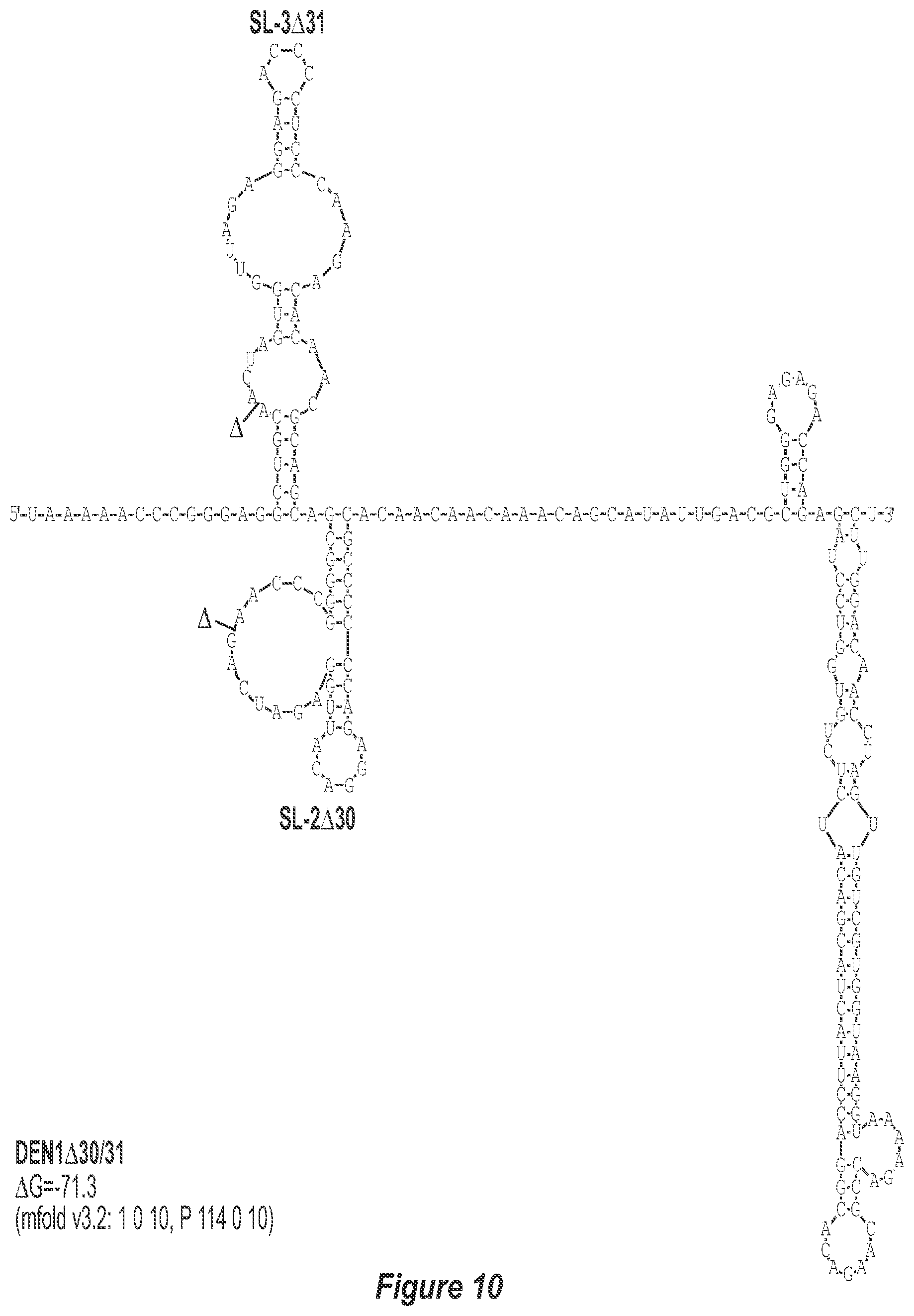
D00014
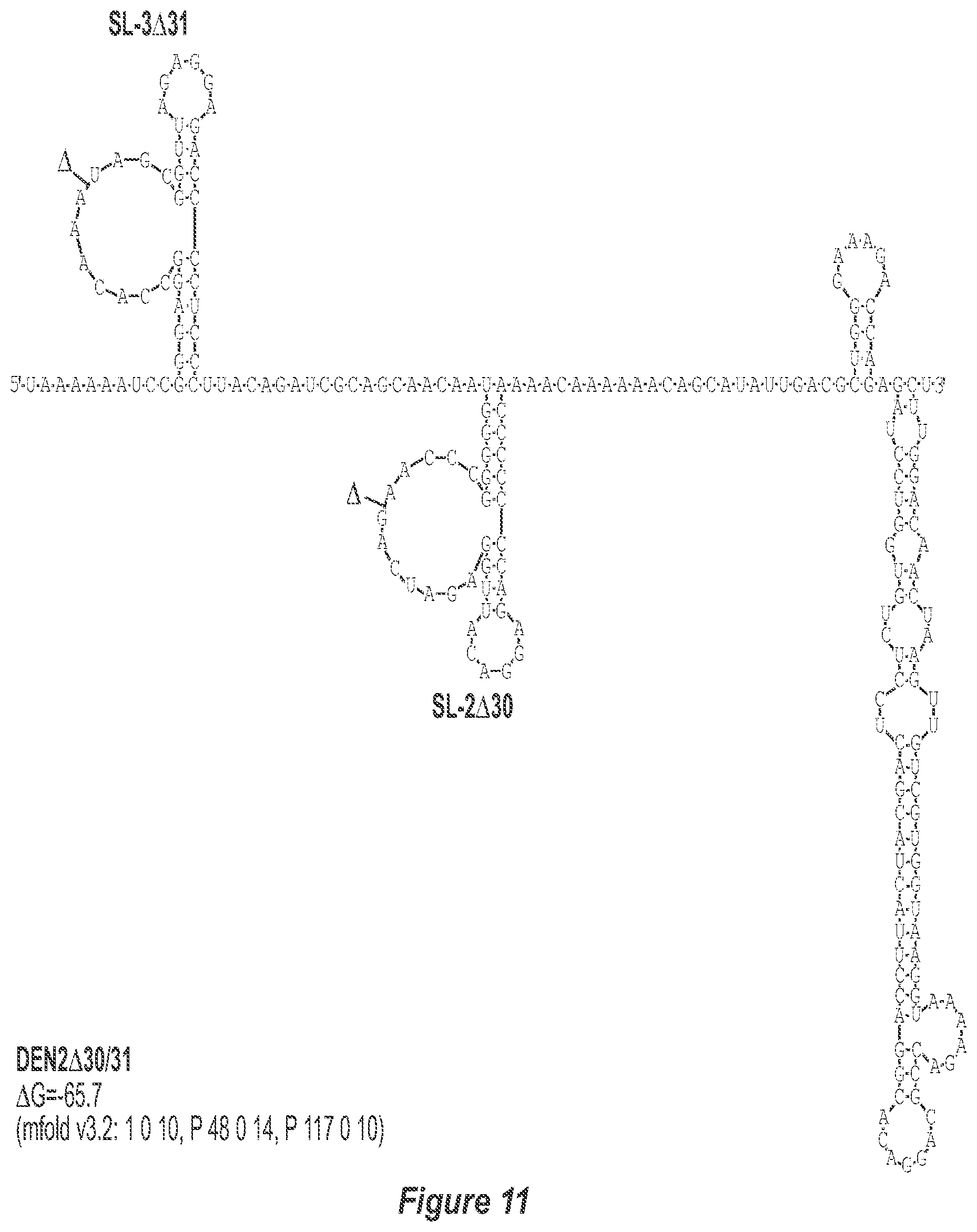
D00015
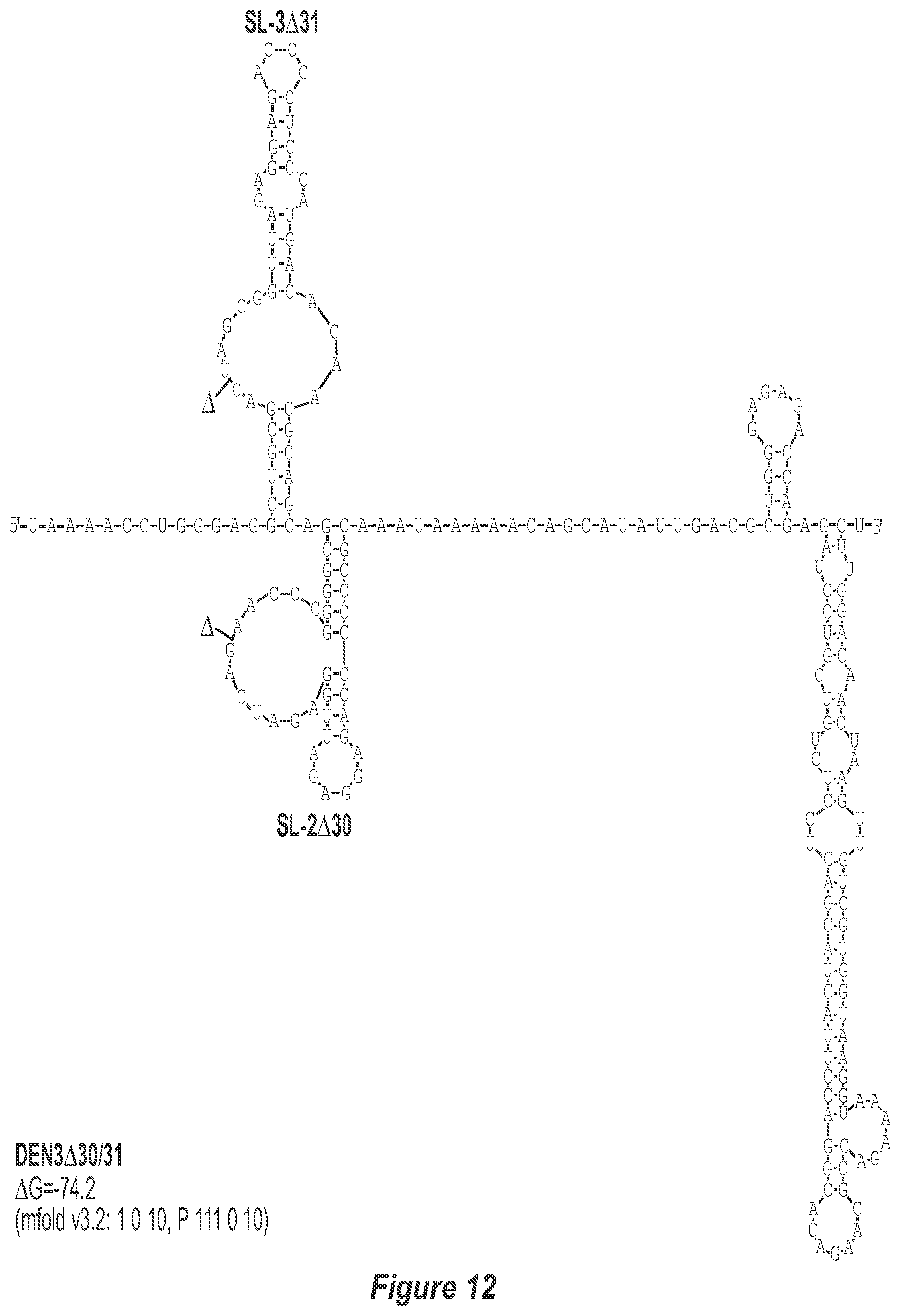
D00016
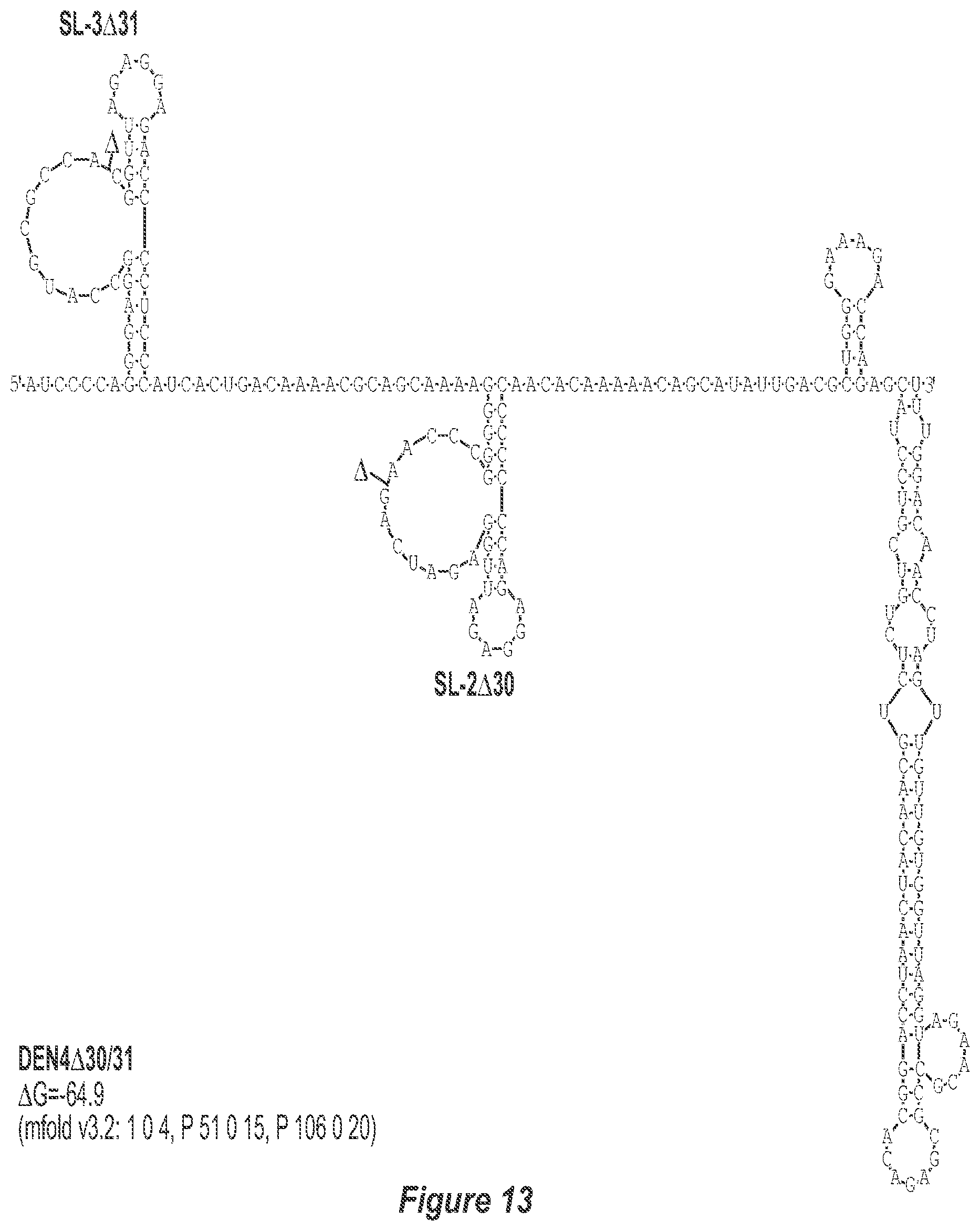
D00017
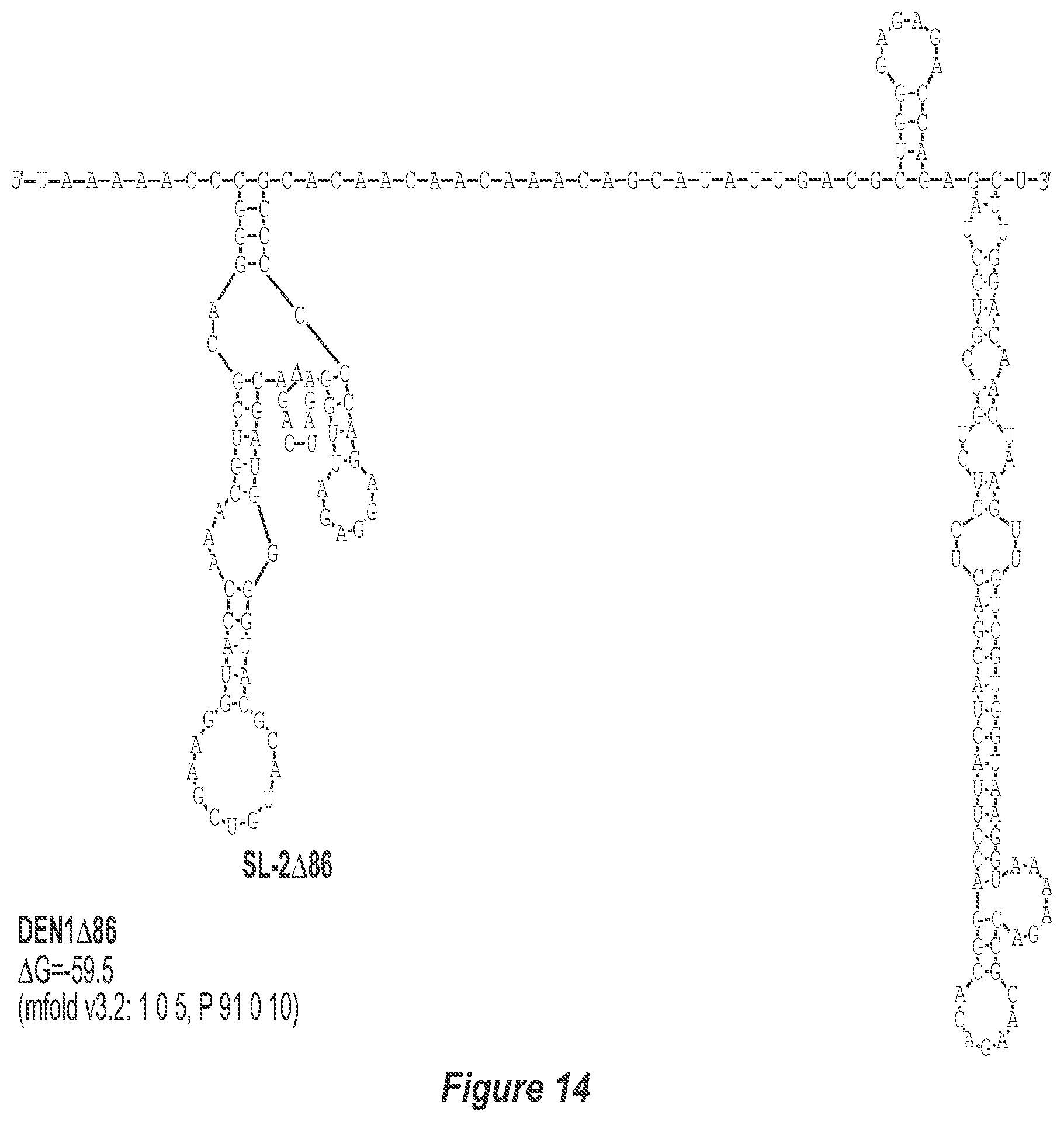
D00018
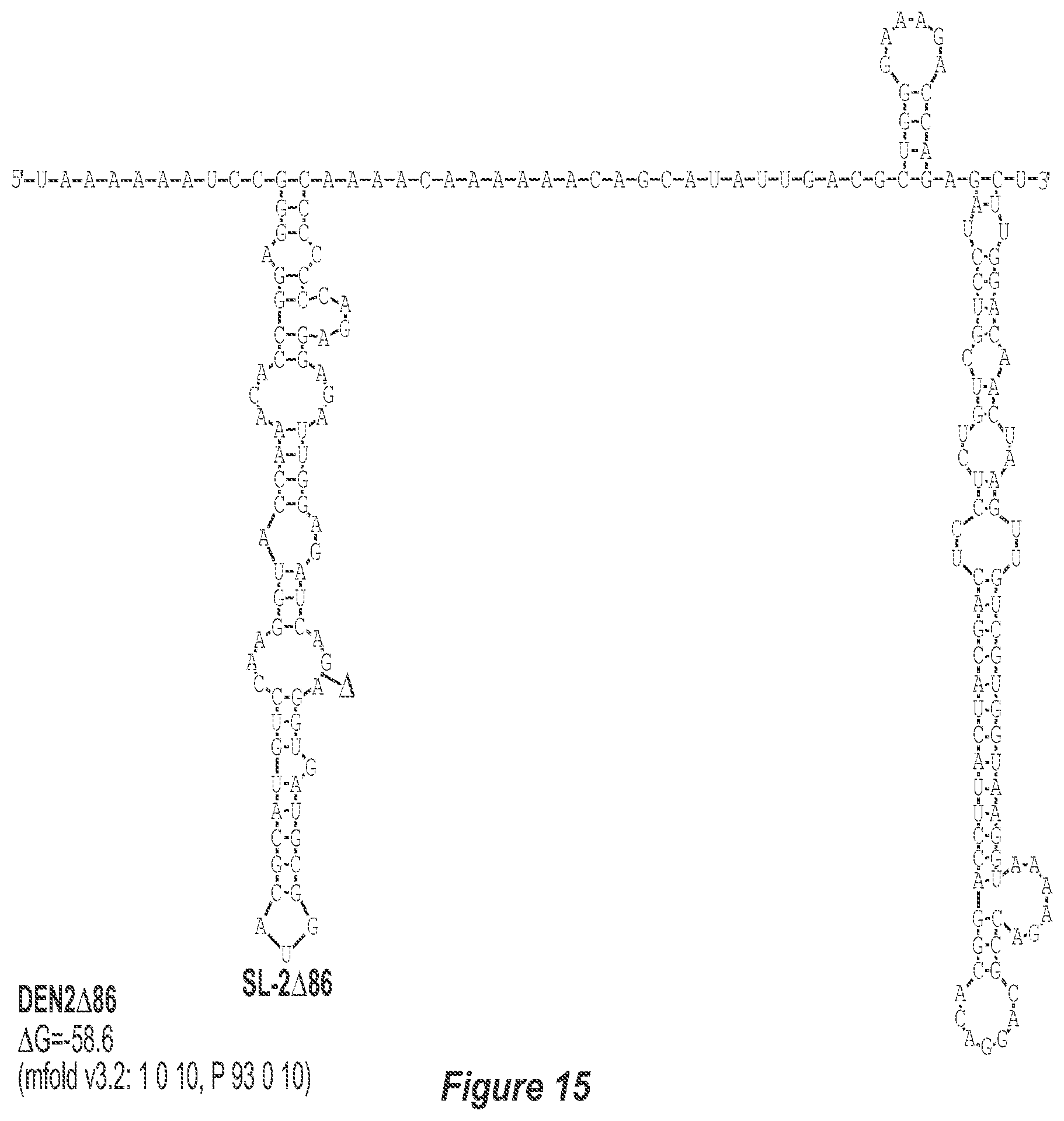
D00019
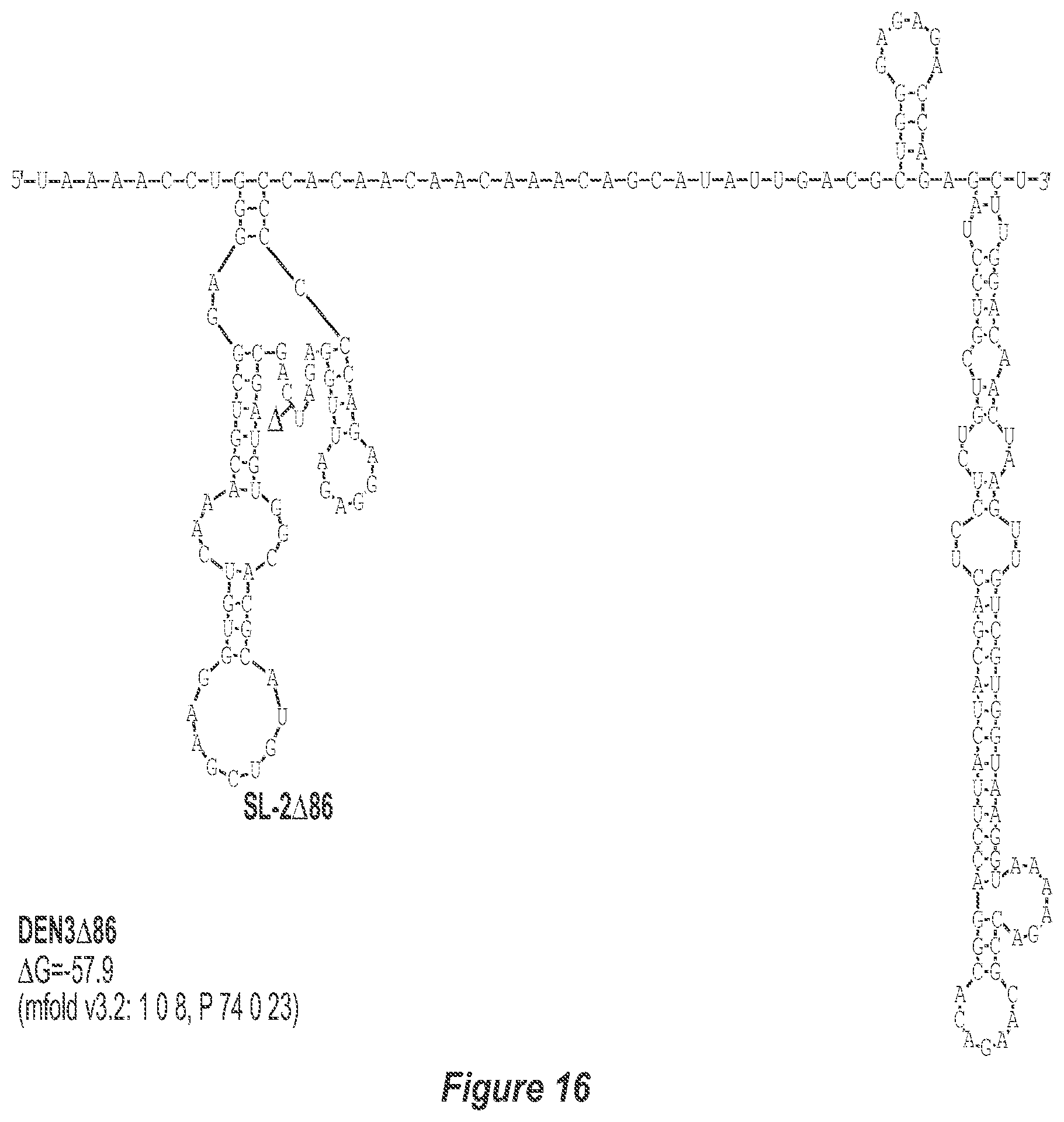
D00020
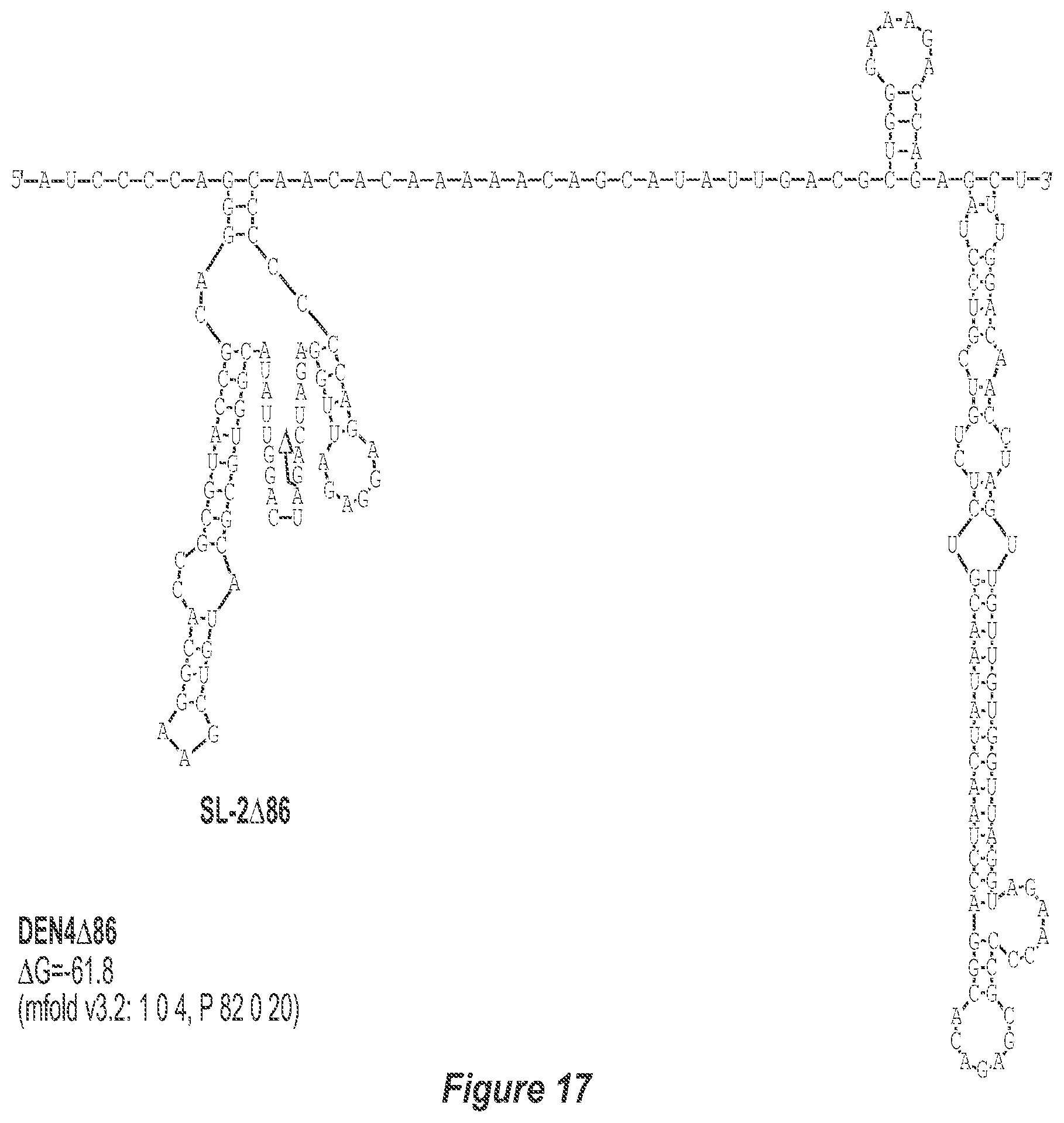
D00021
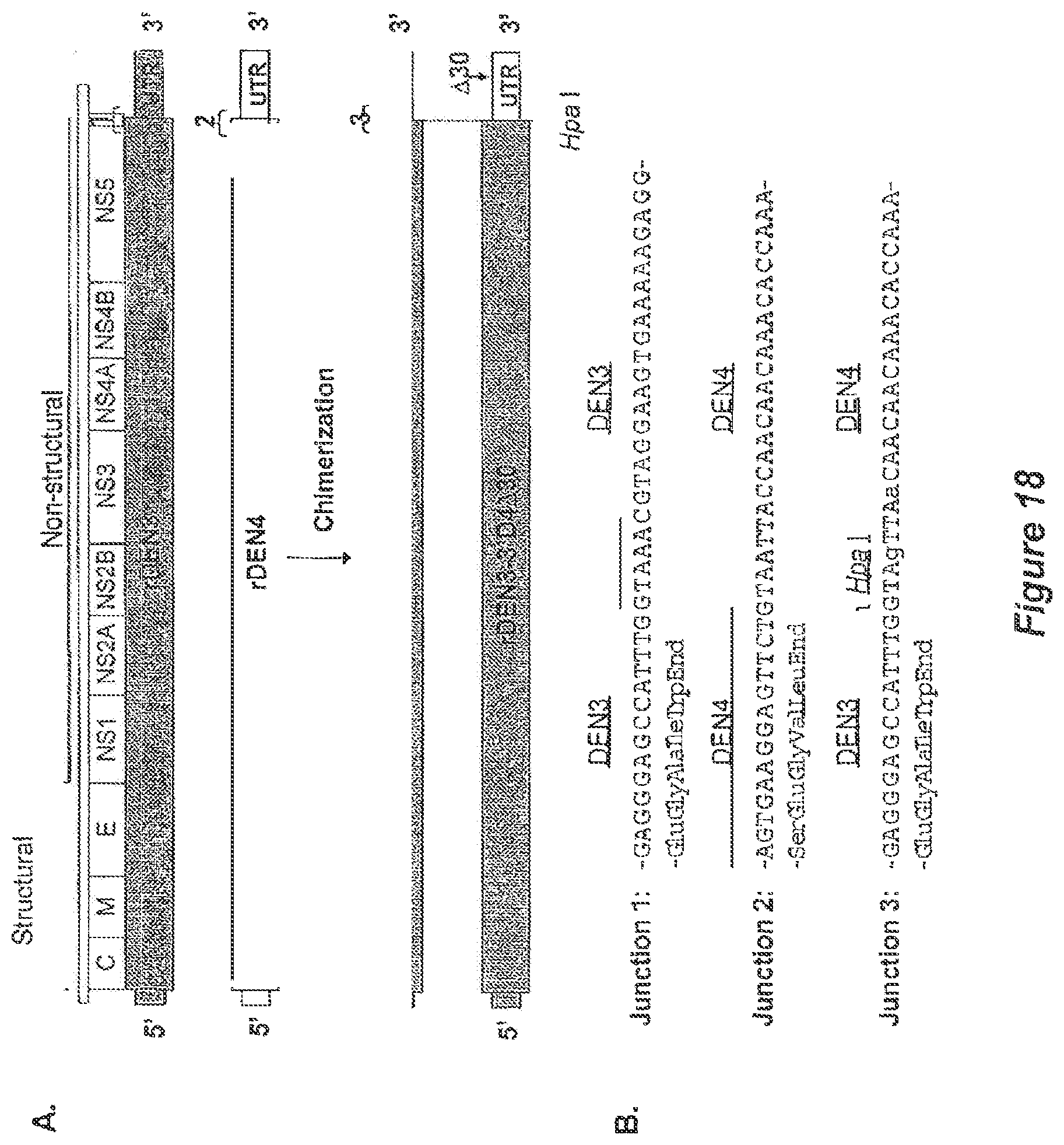
D00022
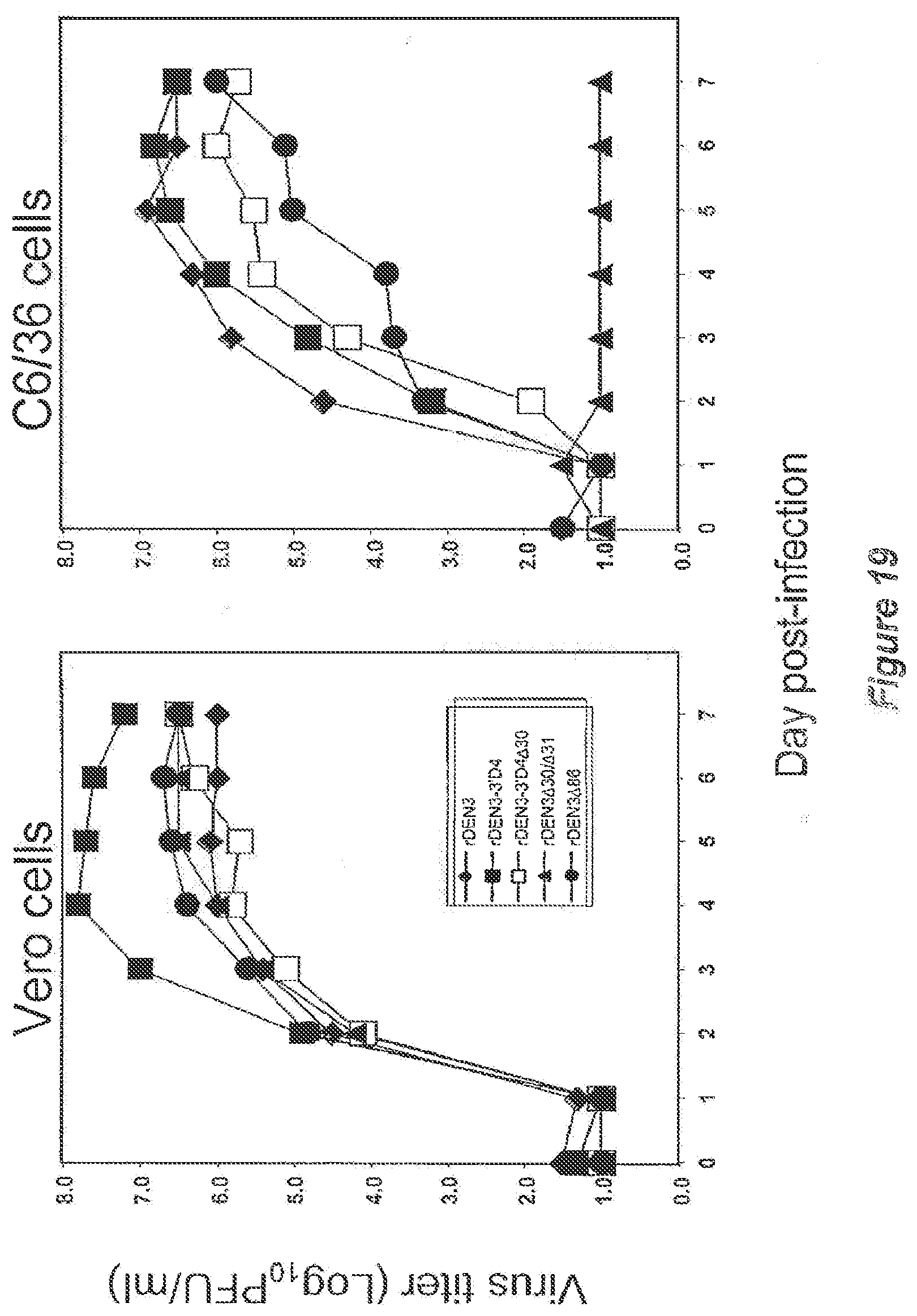
S00001
XML
uspto.report is an independent third-party trademark research tool that is not affiliated, endorsed, or sponsored by the United States Patent and Trademark Office (USPTO) or any other governmental organization. The information provided by uspto.report is based on publicly available data at the time of writing and is intended for informational purposes only.
While we strive to provide accurate and up-to-date information, we do not guarantee the accuracy, completeness, reliability, or suitability of the information displayed on this site. The use of this site is at your own risk. Any reliance you place on such information is therefore strictly at your own risk.
All official trademark data, including owner information, should be verified by visiting the official USPTO website at www.uspto.gov. This site is not intended to replace professional legal advice and should not be used as a substitute for consulting with a legal professional who is knowledgeable about trademark law.